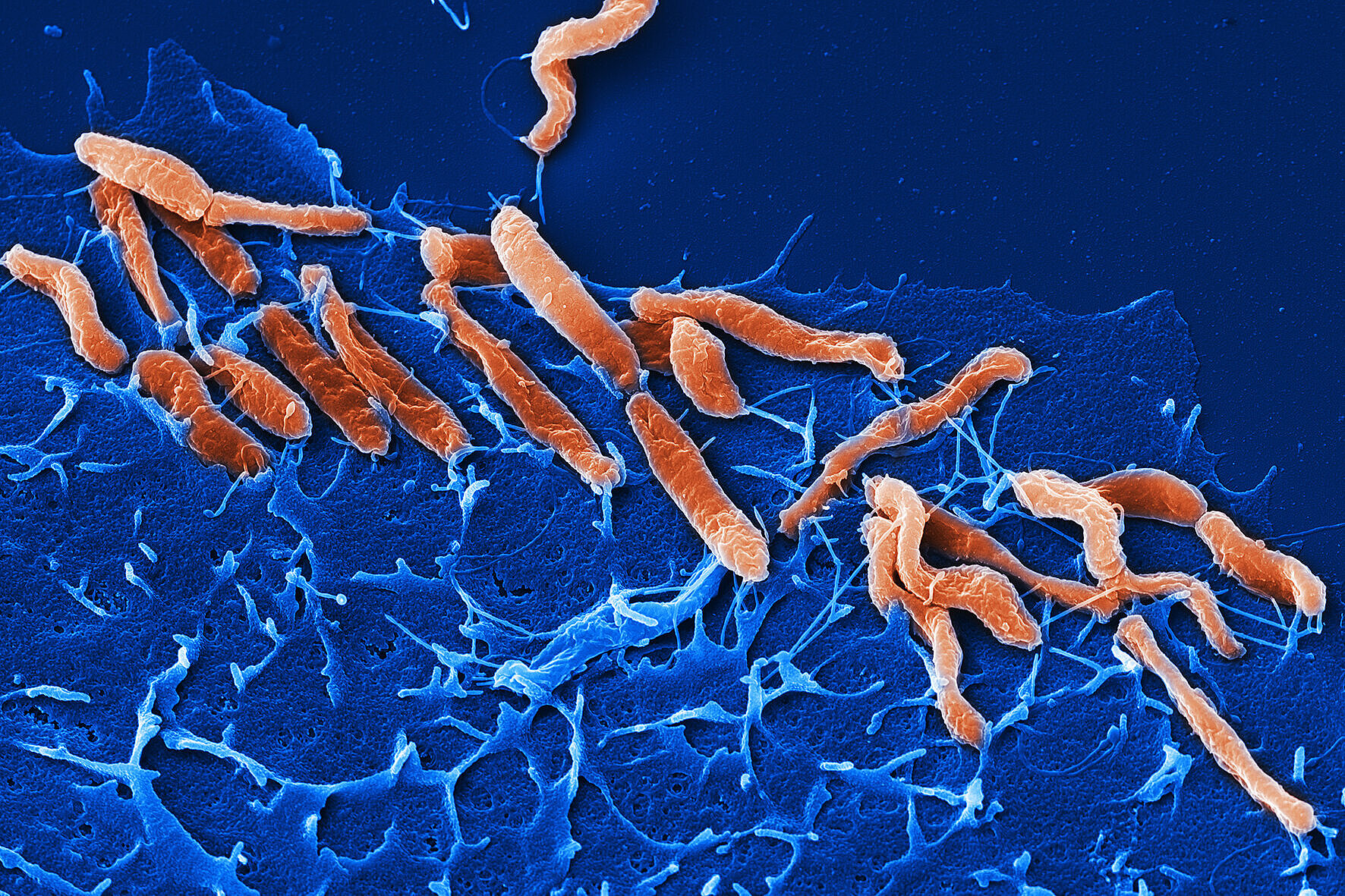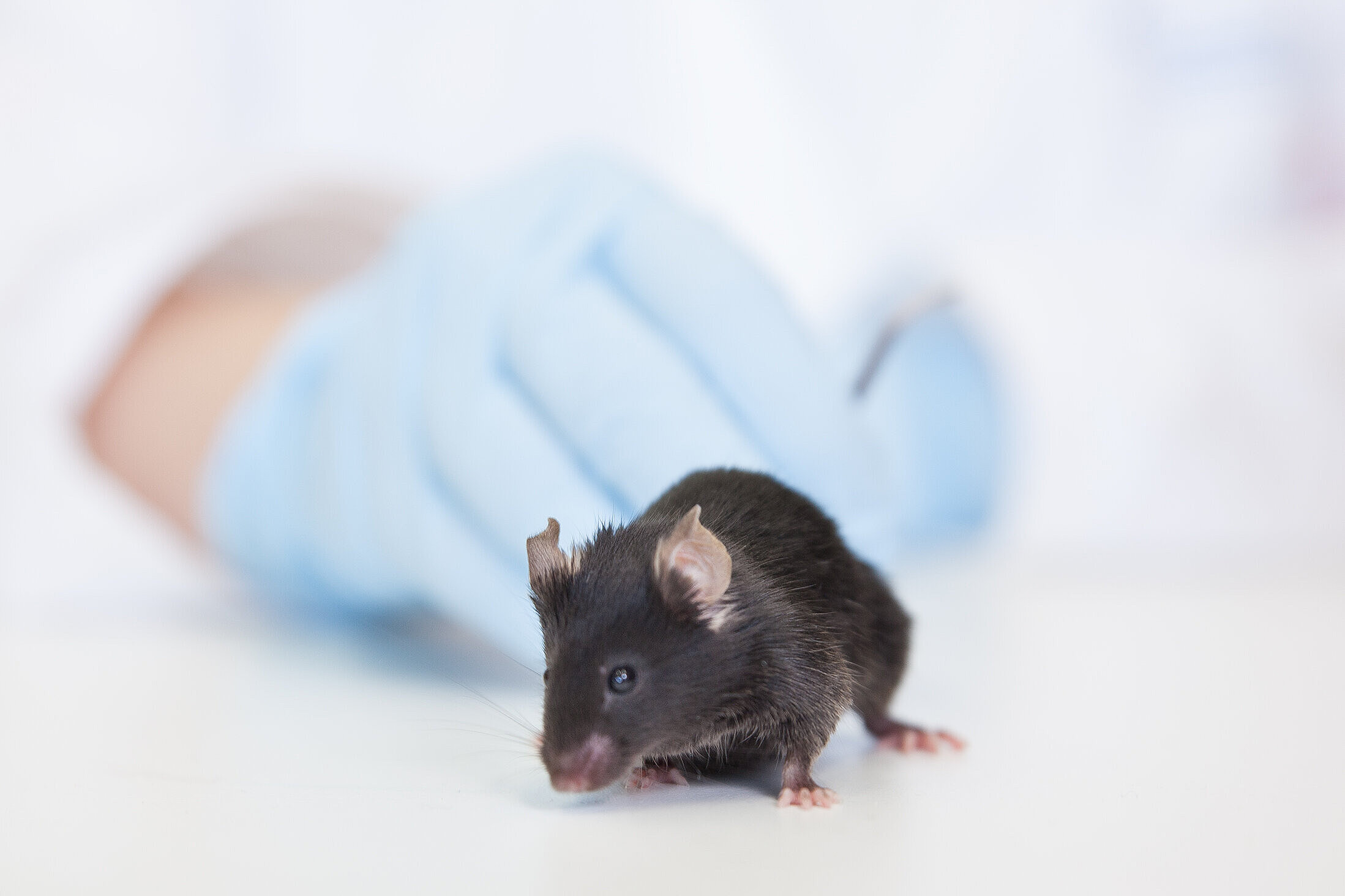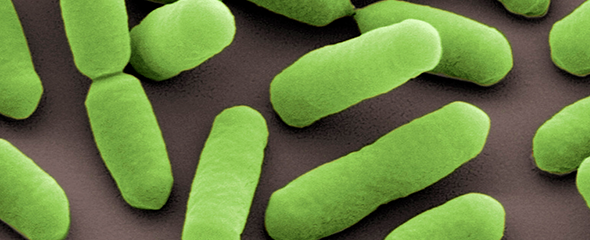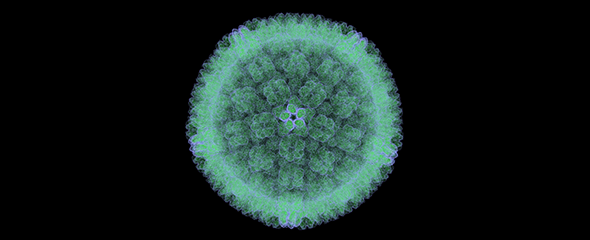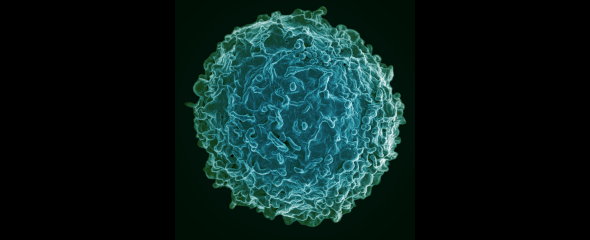Author count: 12
Hillenbrand M., Esslinger C., Seidenberg J., Weber M., Zingg A., Townsend C., Eicher B., Rutkauskaite J., Riese P., Guzman C.A., ... , Fischer K., Schmitt S.
(2024)
Fast-Track Discovery of SARS-CoV-2-Neutralizing Antibodies from Human B Cells by Direct Functional Screening
Viruses., 16 (3)
Author count: 28
Jungbluth S., Martin W., Slezak M., Depraetere H., Guzman C.A., Ussi A., Morrow D., van Heuverswyn F., Arnouts S., Carrondo M.J.T., Olesen O., Ottenhoff T.H.M., Dockrell H.M., Ho M.M., Dobly A., Christensen D., Segales J., Laurent F., Lantier F., Stockhofe-Zurwieden N., Morelli F., Langermans J.A.M., Verreck F.A.W., Le Grand R., Sloots A., Medaglini D., ... , Lawrenz M., Collin N.
(2023)
Potential business model for a European vaccine R&D infrastructure and its estimated socio-economic impact
F1000Research, 12
Author count: 10
Mendez Y., Vasco A.V., Ebensen T., Schulze K., Yousefi M., Davari M., Wessjohann L.A., Guzman C.A., ... , Rivera D.G., Westermann B.
(2023)
Diversification of a Novel a
Angew.Chem.Int.Ed Engl.
Author count: 8
Lopez-Serrano S., Mahmmod Y.S., Christensen D., Ebensen T., Guzman C.A., Rodriguez F., ... , Segales J., Aragon V.
(2023)
Immune responses following neonatal vaccination with conserved F4 fragment of VtaA proteins from virulent Glaesserella parasuis adjuvanted with CAF®01 or CDA
Vaccine X., 14
Author count: 18
Paschold L., Gottschick C., Langer S., Klee B., Diexer S., Aksentijevich I., Schultheiß C., Purschke O., Riese P., Trittel S., Haase R., Dressler F., Eberl W., Hübner J., Strowig T., Guzman C.A., ... , Mikolajczyk R., Binder M.
(2023)
T cell repertoire breadth is associated with the number of acute respiratory infections in the LoewenKIDS birth cohort
Sci.Rep., 13 (1)
Author count: 6
Ebensen T., Arntz A., Schulze K., Hanefeld A., Guzman C.A., Scherließ R.
(2023)
Pulmonary Application of Novel Antigen-Loaded Chitosan Nano-Particles Co-Administered with the Mucosal Adjuvant C-Di-AMP Resulted in Enhanced Immune Stimulation and Dose Sparing Capacity
Pharmaceutics., 15 (4)
Author count: 8
Demuth L., Ohm M., Michaelsen-Preusse K., Schulze K., Riese P., Guzman C.A., ... , Korte M., Hosseini S.
(2023)
Influenza vaccine is able to prevent neuroinflammation triggered by H7N7 IAV infection
Frontiers in Pharmacology, 14
Author count: 6
Sanchez M.V., Ebensen T., Schulze K., Cargnelutti D.E., Scodeller E.A., Guzmán C.A.
(2023)
Protective Efficacy of a Mucosal Influenza Vaccine Formulation Based on the Recombinant Nucleoprotein Co-Administered with a TLR2/6 Agonist BPPcysMPEG
Pharmaceutics., 15 (3)
Author count: 8
Zayed A.R., Bitar D.M., Steinert M., Lück C., Spröer C., Brettar I., ... , Höfle M.G., Bunk B.
(2023)
Comparative Genomics of Legionella pneumophila Isolates from the West Bank and Germany Support Molecular Epidemiology of Legionnaires' Disease
Microorganisms., 11 (2)
Author count: 16
Demoulins T., Schulze K., Ebensen T., Techakriengkrai N., Nedumpun T., Englezou P.C., Gerber M., Hlushchuk R., Toledo D., Djonov V., von Gunten S., McCullough K.C., Liniger M., Guzmán C.A., ... , Suradhat S., Ruggli N.
(2023)
Coatsome-replicon vehicles: Self-replicating RNA vaccines against infectious diseases
Nanomedicine.
Author count: 8
Ramponi F., Aerts C., Sartor P., Pinazo M.J., Freilij H., Guzmán C.A., ... , Malchiodi E., Sicuri E.
(2022)
Development of vaccines for Chagas disease (CRUZIVAX): stakeholders' preferences and potential impacts on healthcare
Gaceta Sanit., 37
Author count: 19
Riese P., Trittel S., Akmatov M.K., May M., Prokein J., Illig T., Schindler C., Sawitzki B., Elfaki Y., Floess S., Huehn J., Blazejewski A.J., Strowig T., Hernandez-Vargas E.A., Geffers R., Zhang B., Li Y., ... , Pessler F., Guzmán C.A.
(2022)
Distinct immunological and molecular signatures underpinning influenza vaccine responsiveness in the elderly
Nat.Commun., 13 (1)
Author count: 15
Wagner A.K., Kadri N., Tibbitt C., van de Ven K., Bagawath-Singh S., Oliinyk D., LeGresley E., Campbell N., Trittel S., Riese P., Ribacke U., Sandalova T., Achour A., ... , Kärre K., Chambers B.J.
(2022)
PD-1 expression on mouse intratumoral NK cells and its effects on NK cell phenotype
iScience, 25 (10)
Author count: 12
Fernandes B., Sousa M., Castro R., Schäfer A., Hauser J., Schulze K., Amacker M., Tamborrini M., Pluschke G., Alves P.M., ... , Fleury S., Roldáo A.
(2022)
Scalable Process for High-Yield Production of PfCyRPA Using Insect Cells for Inclusion in a Malaria Virosome-Based Vaccine Candidate
Front Bioeng.Biotechnol., 10
Author count: 17
Hochnadel I., Hoenicke L., Petriv N., Neubert L., Reinhard E., Hirsch T., Alfonso J.C.L., Suo H., Longerich T., Geffers R., Lichtinghagen R., Guzmán C.A., Wedemeyer H., Lenzen H., Manns M.P., ... , Bruder D., Yevsa T.
(2022)
Correction: Safety and efficacy of prophylactic and therapeutic vaccine based on live-attenuated Listeria monocytogenes in hepatobiliary cancers (Oncogene, (2022), 41, 14, (2039-2053), 10.1038/s41388-022-02222-z)
Oncogene, 41 (19)
Author count: 4
Caputo A., Guzmán C.A., Palmer C.S., Nicoli F.
(2022)
Editorial: The Role of Systemic and Cellular Metabolism on Susceptibility to Infections and Responsiveness to Vaccination
Front Cell Infect Microbiol, 12
Author count: 17
Hochnadel I., Hoenicke L., Petriv N., Neubert L., Reinhard E., Hirsch T., Alfonso J.C.L., Suo H., Longerich T., Geffers R., Lichtinghagen R., Guzmán C.A., Wedemeyer H., Lenzen H., Manns M.P., ... , Bruder D., Yevsa T.
(2022)
Safety and efficacy of prophylactic and therapeutic vaccine based on live-attenuated Listeria monocytogenes in hepatobiliary cancers
Oncogene
Author count: 21
Kim Y., Zheng X., Eschke K., Chaudhry M.Z., Bertoglio F., Tomic A., Krmpotic A., Hoffmann M., Bar-On Y., Boehme J., Bruder D., Ebensen T., Brunotte L., Ludwig S., Messerle M., Guzmán C., Mandelboim O., Hust M., Pöhlmann S., ... , Jonjic S., Cicin-Sain L.
(2022)
MCMV-based vaccine vectors expressing full-length viral proteins provide long-term humoral immune protection upon a single-shot vaccination
Cell Mol.Immunol., 19 (2)
Author count: 33
Langer S., Horn J., Gottschick C., Klee B., Purschke O., Caputo M., Dorendorf E., Meyer-Schlinkmann K.M., Raupach-Rosin H., Karch A., Rübsamen N., Aydogdu M., Buhles M., Dressler F., Eberl W., von Koch F.E., Frambach T., Franz H., Guthmann F., Guzmán C.A., Haase R., Hansen G., Heselich V., Hübner J., Koch H.G., Oberhoff C., Riese P., Schild R., Seeger S., Tchirikov M., Trittel S., ... , Von Kaisenberg C., Mikolajczyk R.
(2022)
Symptom Burden and Factors Associated with Acute Respiratory Infections in the First Two Years of Life -
Microorg., 10 (1)
Author count: 21
Sohail A., Iqbal A.A., Sahini N., Chen F., Tantawy M., Waqas F., Winterhoff M., Ebensen T., Schultz K., Geffers R., Schughart K., Preusse M., Shehata M., Bähre H., Pils M.C., Guzmán C.A., Mostafa A., Pleschka S., Falk C., ... , Michelucci A., Pessler F.
(2022)
Itaconate and derivatives reduce interferon responses and inflammation in influenza A virus infection
PLoS Pathog., 18 (1)
Author count: 10
Lopez-Serrano S., Cordoba L., Perez-Maillo M., Pleguezuelos P., Remarque E.J., Ebensen T., Guzmán C.A., Christensen D., ... , Segales J., Darji A.
(2021)
Immune responses to pandemic h1n1 influenza virus infection in pigs vaccinated with a conserved hemagglutinin HA1 peptide adjuvanted with CAF-®01 or CDA/ a
Vaccines, 9 (7)
Author count: 10
Lanfermann C., Wintgens S., Ebensen T., Kohn M., Laudeley R., Schulze K., Rheinheimer C., Hegemann J.H., ... , Guzmán C.A., Klos A.
(2021)
Prophylactic multi-subunit vaccine against chlamydia trachomatis: In vivo evaluation in mice
Vaccines, 9 (6)
Author count: 14
Graalmann T., Borst K., Manchanda H., Vaas L., Bruhn M., Graalmann L., Köster M., Verboom M., Hallensleben M., Guzmán C.A., Sutter G., Schmidt R.E., ... , Witte T., Kalinke U.
(2021)
B cell depletion impairs vaccination-induced CD8+T cell responses in a type i interferon-dependent manner
Annals of the Rheumatic Diseases
Author count: 14
Shukla D., Patidar A., Sarma U., Chauhan P., Pandey S.P., Chandel H.S., Bodhale N., Ghosh S.K., Guzmán C.A., Ebensen T., Silvestre R., Sarkar A., ... , Saha B., Bhattacharjee S.
(2021)
Interdependencies between Toll-like receptors in Leishmania infection
Immunology, 164 (1)
Author count: 10
Sharma A., Sanduja P., Anand A., Mahajan P., Guzmán C.A., Yadav P., Awasthi A., Hanski E., ... , Dua M., Johri A.K.
(2021)
Advanced strategies for development of vaccines against human bacterial pathogens
World J.Microbiol.Biotechnol., 37 (4)
Author count: 6
Lirussi D., Weissmann S.F., Ebensen T., Nitsche-Gloy U., Franz H.B.G., Guzmán C.A.
(2021)
Cyclic di-adenosine monophosphate: A promising adjuvant candidate for the development of neonatal vaccines
Pharmaceutics, 13 (2)
Author count: 8
Demoulins T., Ruggli N., Gerber M., Thomann-Harwood L.J., Ebensen T., Schulze K., ... , Guzmán C.A., McCullough K.C.
(2021)
Self-Amplifying Pestivirus Replicon RNA Encoding Influenza Virus Nucleoprotein and Hemagglutinin Promote Humoral and Cellular Immune Responses in Pigs
Front Immunol., 11
Author count: 6
Francis Z., Incerti S., Zein S.A., Lampe N., Guzmán C.A., Durante M.
(2021)
Monte Carlo Simulation of SARS-CoV-2 Radiation-Induced Inactivation for Vaccine Development
Radiat.Res., 195 (3)
Author count: 6
Durante M., Schulze K., Incerti S., Francis Z., Zein S., Guzmán C.A.
(2020)
Virus Irradiation and COVID-19 Disease
Front.Phys., 8
Author count: 8
Pogozhykh D., Eicke D., Gryshkov O., Wolkers W.F., Schulze K., Guzmán C.A., ... , Blasczyk R., Figueiredo C.
(2020)
Towards Reduction or Substitution of Cytotoxic DMSO in Biobanking of Functional Bioengineered Megakaryocytes
Int.J.Mol.Sci., 21 (20)
Author count: 1
Guzmán C.A.
(2020)
Next Generation Influenza Vaccines: Looking into the Crystal Ball
Vaccines.(Basel), 8 (3)
Author count: 10
Zeeb M., Kerrinnes T., Cicin-Sain L., Guzmán C.A., Puppe W., Schulz T.F., Peters A., Berger K., ... , Castell S., Karch A.
(2020)
Seropositivity for pathogens associated with chronic infections is a risk factor for all-cause mortality in the elderly: findings from the Memory and Morbidity in Augsburg Elderly (MEMO) Study
Geroscience., 42 (5)
Author count: 9
Montefusco-Pereira C.V., Horstmann J.C., Ebensen T., Beisswenger C., Bals R., Guzmán C.A., Schneider-Daum N., ... , Carvalho-Wodarz C.S., Lehr C.M.
(2020)
P. aeruginosa Infected 3D Co-Culture of Bronchial Epithelial Cells and Macrophages at Air-Liquid Interface for Preclinical Evaluation of Anti-Infectives
J.Vis.Exp. (160)
Author count: 6
Riese P., Trittel S., Pathirana R.D., Klawonn F., Cox R.J., Guzmán C.A.
(2020)
Responsiveness to influenza vaccination correlates with nkg2c-expression on nk cells
Vaccines.(Basel), 8 (2)
Author count: 8
Patidar A., Selvaraj S., Chauhan P., Guzmán C.A., Ebenson T., Sarkar A., ... , Chattopadhyay D., Saha B.
(2020)
Peptidoglycan-treated tumor antigen-pulsed dendritic cells impart complete resistance against tumor rechallenge
Clin.Exp.Immunol., 201 (3)
Author count: 8
Freuer D., Linseisen J., Waterboer T., Pessler F., Guzmán C.A., Wawro N., ... , Peters A., Meisinger C.
(2020)
Seropositivity of selected chronic infections and different measures of obesity
PLoS.ONE., 15 (4)
Author count: 12
Bugatti A., Marsico S., Mazzuca P., Schulze K., Ebensen T., Giagulli C., Pena E., Badimón L., Slevin M., Caruso A., ... , Guzmán C.A., Caccuri F.
(2020)
Role of autophagy in von willebrand factor secretion by endothelial cells and in the in vivo thrombin-antithrombin complex formation promoted by the hiv-1 matrix protein p17
Int.J.Mol.Sci., 21 (6)
Author count: 13
Sanchez Alberti A., Bivona A.E., Matos M.N., Cerny N., Schulze K., Weissmann S., Ebensen T., Gonzalez G., Morales C., Cardoso A.C., Cazorla S.I., ... , Guzmán C.A., Malchiodi E.L.
(2020)
Mucosal Heterologous Prime/Boost Vaccination Induces Polyfunctional Systemic Immunity, Improving Protection Against Trypanosoma cruzi
Front Immunol., 11
Author count: 14
Böning M.A.L., Trittel S., Riese P., Van Ham M., Heyner M., Voss M., Parzmair G.P., Klawonn F., Jeron A., Guzmán C.A., Jänsch L., Schraven B., ... , Reinhold A., Bruder D.
(2020)
ADAP Promotes Degranulation and Migration of NK Cells Primed During in vivo Listeria monocytogenes Infection in Mice
Front.Immunol., 10
Author count: 4
Ebensen T., Fuchs B., Schulze K., Guzmán C.A.
(2019)
Infection prevention: oil- and lipid-containing products in vaccinology
(7)
Author count: 17
Michler T., Kosinska A.D., Festag J., Bunse T., Su J., Ringelhan M., Imhof H., Grimm D., Steiger K., Mogler C., Heikenwalder M., Michel M.L., Guzmán C.A., Milstein S., Sepp-Lorenzino L., ... , Knolle P., Protzer U.
(2020)
Knockdown of Virus Antigen Expression Increases Therapeutic Vaccine Efficacy in High-titer HBV Carrier Mice
Gastroenterology, 158 (6)
Author count: 11
Batyrova B., Luwaert F., Maravelia P., Miyabayashi Y., Vashist N., Stark J.M., Soori S.Y., Tibbitt C.A., Riese P., ... , Coquet J.M., Chambers B.J.
(2020)
PD-1 expression affects cytokine production by ILC2 and is influenced by peroxisome proliferator-activated receptor-?
Immun.Inflamm.Dis., 8 (1)
Author count: 5
Trittel S., Chambers B.J., Heise U., Guzmán C.A., Riese P.
(2019)
Key features and homing properties of NK cells in the liver are shaped by activated iNKT cells
Sci.Rep., 9 (1)
Author count: 12
Zheng X., Oduro J.D., Boehme J.D., Borkner L., Ebensen T., Heise U., Gereke M., Pils M.C., Krmpotic A., Guzmán C.A., ... , Bruder D., Cicin-Sain L.
(2019)
Mucosal CD8+ T cell responses induced by an MCMV based vaccine vector confer protection against influenza challenge
PLoS Pathog., 15 (9)
Author count: 9
Sharma-Chawla N., Stegemann-Koniszewski S., Christen H., Boehme J.D., Kershaw O., Schreiber J., Guzmán C.A., ... , Bruder D., Hernandez-Vargas E.A.
(2019)
In vivo Neutralization of Pro-inflammatory Cytokines During Secondary Streptococcus pneumoniae Infection Post Influenza A Virus Infection
Front Immunol., 10
Author count: 6
Trittel S., Vashist N., Ebensen T., Chambers B.J., Guzmán C.A., Riese P.
(2019)
Invariant NKT Cell-Mediated Modulation of ILC1s as a Tool for Mucosal Immune Intervention
Front Immunol., 10
Author count: 44
Gottschick C., Raupach-Rosin H., Langer S., Hassan L., Horn J., Dorendorf E., Caputo M., Bittner M., Beier L., Rübsamen N., Schlinkmann K., Zoch B., Guzmán C.A., Hansen G., Heselich V., Holzapfel E., Hübner J., Pietschmann T., Pieper D.H., Pletz M., Riese P., Schmidt-Pokrzywniak A., Hartwig S., Von Kaisenberg C., Aydogdu M., Buhles M., Dressler F., Eberl W., Haase R., von Koch F.E., Feidicker S., Frambach T., Franz H.G.B., Guthmann F., Koch H.G., Seeger S., Oberhoff C., Pauker W., Petry K.U., Schild R.L., Tchirikov M., Röhrig E., ... , Karch A., Mikolajczyk R.
(2019)
Erratum: Cohort profile: The LoewenKIDS Study - Life-course perspective on infections, the microbiome and the development of the immune system in early childhood (International Journal of Epidemiology (2019) DOI: 10.1093/ije/dyz001)
Int.J.Epidemiol., 48 (4)
Author count: 6
Perche F., Clemencon R., Schulze K., Ebensen T., Guzmán C.A., Pichon C.
(2019)
Neutral Lipopolyplexes for In Vivo Delivery of Conventional and Replicative RNA Vaccine
Mol.Ther.Nucl.Acids, 17 (September)
Author count: 9
Akmatov M.K., Riese P., Trittel S., May M., Prokein J., Illig T., Schindler C., ... , Guzmán C.A., Pessler F.
(2019)
Self-reported diabetes and herpes zoster are associated with a weak humoral response to the seasonal influenza A H1N1 vaccine antigen among the elderly
BMC Infect.Dis., 19 (1)
Author count: 7
Volckmar J., Knop L., Stegemann-Koniszewski S., Schulze K., Ebensen T., ... , Guzmán C.A., Bruder D.
(2019)
The STING activator c-di-AMP exerts superior adjuvant properties than the formulation poly(I:C)/CpG after subcutaneous vaccination with soluble protein antigen or DEC-205-mediated antigen targeting to dendritic cells
Vaccine, 37 (35)
Author count: 6
de Groot C., Müsken M., Bleckmann M., Ebensen T., Guzmán C.A., Müller-Goymann C.C.
(2019)
Novel colloidal associations of soyasaponins and lipid components (DPPC, cholesterol) as potential adjuvants for vaccines
Vaccine, 37 (35)
Author count: 16
Matthijs A.M.F., Auray G., Jakob V., Garcia-Nicolas O., Braun R.O., Keller I., Bruggman R., Devriendt B., Boyen F., Guzmán C.A., Michiels A., Haesebrouck F., Collin N., Barnier-Quer C., ... , Maes D., Summerfield A.
(2019)
Systems Immunology Characterization of Novel Vaccine Formulations for Mycoplasma hyopneumoniae Bacterins
Front Immunol., 10 (May 2019)
Author count: 4
Ebensen T., Schulze K., Prochnow B., Guzmán C.A.
(2018)
Preclinical Animal Models for Developing Vaccines Against Influenza Infection for the Young and the Elderly
(168-1)
Author count: 5
Ebensen T., Delandre S., Prochnow B., Guzmán C.A., Schulze K.
(2019)
The Combination Vaccine Adjuvant System Alum/c-di-AMP Results in Quantitative and Qualitative Enhanced Immune Responses Post Immunization
Front Cell Infect Microbiol, 9 (February)
Author count: 43
Gottschick C., Raupach-Rosin H., Langer S., Hassan L., Horn J., Dorendorf E., Caputo M., Bittner M., Beier L., Rübsamen N., Schlinkmann K., Zoch B., Guzmán C.A., Hansen G., Heselich V., Holzapfel E., Hübner J., Pietschmann T., Pieper D.H., Pletz M., Riese P., Schmidt-Pokrzywniak A., Hartwig S., von Kaisenberg C., Aydogdu M., Buhles M., Dressler F., Eberl W., Haase R., Edler von Koch F., Feidicker S., Frambach T., Franz H.G.B., Guthmann F., Koch H.G., Seeger S., Oberhoff C., Pauker W., Petry K.U., Schild R.L., Tchirikov M., ... , Röhrig E., Mikolajczyk R.
(2019)
Cohort profile: The LoewenKIDS Study - life-course perspective on infections, the microbiome and the development of the immune system in early childhood
Int.J.Epidemiol., 48 (4)
Author count: 23
Theobald S.J., Khailaie S., Meyer-Hermann M., Volk V., Olbrich H., Danisch S., Gerasch L., Schneider A., Sinzger C., Schaudien D., Lienenklaus S., Riese P., Guzmán C.A., Figueiredo C., Von Kaisenberg C., Spineli L.M., Glaesener S., Meyer-Bahlburg A., Ganser A., Schmitt M., MacH M., ... , Messerle M., Stripecke R.
(2018)
Signatures of T and B cell development, functional responses and PD-1 upregulation after HCMV latent infections and reactivations in Nod.Rag.Gamma mice humanized with cord blood CD34+cells
Front.Immunol., 9 (NOV)
Author count: 26
Khera T., Behrendt P., Bankwitz D., Brown R.J.P., Todt D., Doepke M., Khan A.G., Schulze K., Law J., Logan M., Hockman D., Wong J.A.J.-X., Dold L., Gonzalez-Motos V., Spengler U., Viejo-Borbolla A., Ströh L., Krey T., Tarr A.W., Steinmann E., Manns M.P., Klein F., Guzmán C.A., Marcotrigiano J., ... , Houghton M., Pietschmann T.
(2019)
Functional and immunogenic characterization of diverse HCV glycoprotein E2 variants
J.Hepatol., 70 (4)
Author count: 10
Jeron A., Boehme J.D., Volckmar J., Gereke M., Yevsa T., Geffers R., Guzmán C.A., Schreiber J., ... , Stegemann-Koniszewski S., Bruder D.
(2018)
Respiratory bordetella bronchiseptica carriage is associated with broad phenotypic alterations of peripheral CD4+CD25+ T cells and differentially affects immune responses to secondary non-infectious and infectious stimuli in mice
Int.J.Mol.Sci., 19 (9)
Author count: 6
Zygmunt B.M., Wegrzyn A., Gajska W., Yevsa T., Chodaczek G., Guzmán C.A.
(2018)
Mannose Metabolism Is Essential for Th1 Cell Differentiation and IFN-gamma Production
J.Immunol., 201 (5)
Author count: 8
Lirussi D., Ebensen T., Schulze K., Reinhard E., Trittel S., Riese P., ... , Prochnow B., Guzmán C.A.
(2018)
Rapid in vivo assessment of adjuvant's cytotoxic t lymphocytes generation capabilities for vaccine development
J.Visualized Exp., 2018 (136)
Author count: 9
Eicke D., Baigger A., Schulze K., Latham S.L., Halloin C., Zweigerdt R., Guzmán C.A., ... , Blasczyk R., Figueiredo C.
(2018)
Large-scale production of megakaryocytes in microcarrier-supported stirred suspension bioreactors
Sci.Rep., 8 (1)
Author count: 9
Englezou P.C., Sapet C., Milona P., Ebensen T., Schulze K., Guzmán C.A., Poulhes F., ... , Zelphati O., Ruggli N.
(2018)
Self-Amplifying Replicon RNA Delivery to Dendritic Cells by Cationic Lipids
Mol.Ther.Nucl.Acids, 12 (September)
Author count: 6
Vashist N., Trittel S., Ebensen T., Chambers B.J., Guzmán C.A., Riese P.
(2018)
Influenza-activated ILC1s contribute to antiviral immunity partially influenced by differential GITR expression
Front.Immunol., 8 (MAR)
Author count: 10
Stegemann-Koniszewski S., Behrens S., Boehme J.D., Hochnadel I., Riese P., Guzmán C.A., Kröger A., Schreiber J., ... , Gunzer M., Bruder D.
(2018)
Respiratory influenza A virus infection triggers local and systemic natural killer cell activation via toll-like receptor 7
Front.Immunol., 9 (FEB)
Author count: 6
Riehl M., Harms M., Lucas H., Ebensen T., Guzmán C.A., Mäder K.
(2018)
Dual dye in-vivo imaging of differentially charged PLGA carriers reveals antigen-depot effect, leading to improved immune responses in preclinical models
Eur.J.Pharm.Sci., 117
Author count: 12
Sanchez Alberti A., Bivona A.E., Cerny N., Schulze K., Weissmann S., Ebensen T., Morales C., Padilla A.M., Cazorla S.I., Tarleton R.L., ... , Guzmán C.A., Malchiodi E.L.
(2017)
Engineered trivalent immunogen adjuvanted with a STING agonist confers protection against Trypanosoma cruzi infection
NPJ.Vaccines., 2 (1)
Author count: 13
Landi A., Law J., Hockman D., Logan M., Crawford K., Chen C., Kundu J., Ebensen T., Guzmán C.A., Deschatelets L., Krishnan L., ... , Tyrrell D.L.J., Houghton M.
(2017)
Superior immunogenicity of HCV envelope glycoproteins when adjuvanted with cyclic-di-AMP, a STING acitvator or archaeosomes
Vaccine, 35 (50)
Author count: 4
Klingen T.R., Reimering S., Guzmán C.A., McHardy A.C.
(2017)
In Silico Vaccine Strain Prediction for Human Influenza Viruses
Trends Microbiol., 26 (2)
Author count: 9
Ebensen T., Debarry J., Pedersen G.K., Blazejewska P., Weissmann S., Schulze K., McCullough K.C., ... , Cox R.J., Guzmán C.A.
(2017)
Mucosal Administration of Cycle-Di-Nucleotide-Adjuvanted Virosomes Efficiently Induces Protection against Influenza H5N1 in Mice
Front Immunol., 8 (Sep)
Author count: 9
Demoulins T., Ebensen T., Schulze K., Englezou P.C., Milona P., Pelliccia M., Guzmán C.A., ... , Ruggli N., McCullough K.C.
(2017)
Self-replicating RNA vaccine functionality modulated by fine-tuning of polyplex delivery vehicle structure
J.Control Release, 266
Author count: 7
Schulze K., Ebensen T., Chandrudu S., Skwarczynski M., Toth I., ... , Olive C., Guzmán C.A.
(2017)
Bivalent mucosal peptide vaccines administered using the LCP carrier system stimulate protective immune responses against Streptococcus pyogenes infection
Nanomedicine., 13 (8)
Author count: 2
Riese P., Guzmán C.A.
(2017)
Roads to advanced vaccines: influenza case study
Microb.Biotechnol., 10 (5)
Author count: 7
Borsutzky S., Kretschmer K., Becker P.D., Mühlradt P.F., Kirschning C.J., ... , Weiss S., Guzmán C.A.
(2005)
The mucosal adjuvant macrophage-activating lipopeptide-2 directly stimulates B lymphocytes via the TLR2 without the need of accessory cells
J.Immunol., 174 (10)
Author count: 6
Yasar H., Gordon S., Loretz B., Schulze K., Guzmán C.A., Lehr C.-M.
(2016)
Follicular Drug Delivery: a Root to Success - delivering drugs through the skin without the use of needles has proven a significant challenge for the scientific community. But what about exploiting hair follicles?
The Medicine Maker (0816-601)
Author count: 8
Lirussi D., Ebensen T., Schulze K., Trittel S., Duran V., Liebich I., ... , Kalinke U., Guzmán C.A.
(2017)
Type I IFN and not TNF, is Essential for Cyclic Di-nucleotide-elicited CTL by a Cytosolic Cross-presentation Pathway
EBioMedicine., 22
Author count: 7
Schulte A., Balzer K.M., Garritsen H., Legath N., Minol J.-P., ... , Börgel M., Sixt S.U.
(2017)
Cryopreserved vascular grafts from human tissue
Gefässchirurgie, 22 (6)
Author count: 5
Schulze K., Ebensen T., Babiuk L.A., Gerdts V., Guzmán C.A.
(2017)
Intranasal vaccination with an adjuvanted polyphosphazenes nanoparticle-based vaccine formulation stimulates protective immune responses in mice
Nanomedicine., 13 (7)
Author count: 9
Mazzuca P., Marsico S., Schulze K., Mitola S., Pils M.C., Giagulli C., Guzmán C.A., ... , Caruso A., Caccuri F.
(2017)
Role of autophagy in the HIV-1 matrix protein p17-driven lymphangiogenesis
J.Virol., 91 (16)
Author count: 17
Akmatov M.K., Rober N., Ahrens W., Flesch-Janys D., Fricke J., Greiser H., Gunther K., Kaaks R., Kemmling Y., Krone B., Linseisen J., Meisinger C., Moebus S., Obi N., Guzmán C.A., ... , Conrad K., Pessler F.
(2017)
Anti-nuclear autoantibodies in the general German population: prevalence and lack of association with selected cardiovascular and metabolic disorders-findings of a multicenter population-based study
Arthritis Res.Ther., 19 (1)
Author count: 7
Becker P.D., Nörder M., Weissmann S., Ljapoci R., Erfle V., ... , Drexler I., Guzmán C.A.
(2014)
Gene expression driven by a strong viral promoter in MVA increases vaccination efficiency by enhancing antibody responses and unmasking CD8+ t cell Epitopes
Vaccines, 2 (3)
Author count: 2
Guzmán C.A., Timmis Kenneth N.*
(2011)
Towards intelligent vaccines: the VAC-CHIP.
Microbial Biotechnology, 4 (2)
Author count: 6
Khanam A., TrehanPati N., Riese P., Rastogi A., Guzmán C.A., Sarin S.K.
(2017)
Blockade of Neutrophil's Chemokine Receptors CXCR1/2 Abrogate Liver Damage in Acute-on-Chronic Liver Failure
Front Immunol., 8
Author count: 6
Rueckert C., Rand U., Roy U., Kasmapour B., Strowig T., Guzmán C.A.
(2017)
Cyclic dinucleotides modulate induced type I IFN responses in innate immune cells by degradation of STING
FASEB J., 31 (7)
Author count: 19
Akmatov M.K., Riese P., May M., Jentsch L., Ahmed M.W., Werner D., Rosel A., Tyler M., Pessler K., Prokein J., Bernemann I., Klopp N., Prochnow B., Trittel S., Tallam A., Illig T., Schindler C., ... , Guzmán C.A., Pessler F.
(2017)
Establishment of a cohort for deep phenotyping of the immune response to influenza vaccination among elderly individuals recruited from the general population
Hum.Vaccin.Immunother.
Author count: 14
Volckmar J., Gereke M., Ebensen T., Riese P., Philipsen L., Lienenklaus S., Wohlleber D., Klopfleisch R., Stegemann-Koniszewski S., Muller A.J., Gruber A.D., Knolle P., ... , Guzmán C.A., Bruder D.
(2017)
Targeted antigen delivery to dendritic cells elicits robust antiviral T cell-mediated immunity in the liver
Sci Rep., 7 (Mar)
Author count: 8
Chatterjea A., Lapointe V.L.S., Barradas A., Garritsen H., Yuan H., Renard A., ... , Van Blitterswijk C.A., De Boer J.
(2017)
Cell aggregation enhances bone formation by human mesenchymal stromal cells
Eur.Cells and Mater., 33
Author count: 6
Matos M.N., Cazorla S.I., Schulze K., Ebensen T., Guzmýan C.A., Malchiodi E.L.
(2017)
Immunization with Tc52 or its amino terminal domain adjuvanted with c-di-AMP induces Th17+Th1 specific immune responses and confers protection against Trypanosoma cruzi
PLoS.Negl.Trop.Dis., 11 (2)
Author count: 14
Ziegler A., Soldner C., Lienenklaus S., Spanier J., Trittel S., Riese P., Kramps T., Weiss S., Heidenreich R., Jasny E., Guzmán C.A., Kallen K.J., ... , Fotin-Mleczek M., Kalinke U.
(2017)
A New RNA-Based Adjuvant Enhances Virus-Specific Vaccine Responses by Locally Triggering TLR- and RLH-Dependent Effects
J Immunol., 198 (4)
Author count: 15
Akmatov M.K., Jentsch L., Riese P., May M., Ahmed M.W., Werner D., Rösel A., Prokein J., Bernemann I., Klopp N., Prochnow B., Illig T., Schindler C., ... , Guzmán C.A., Pessler F.
(2017)
Motivations for (non)participation in population-based health studies among the elderly - comparison of participants and nonparticipants of a prospective study on influenza vaccination
BMC Med.Res.Methodol., 17 (1)
Author count: 11
Tomic A., Varanasi P.R., Golemac M., Malic S., Riese P., Borst E.M., Mischak-Weissinger E., Guzmán C.A., Krmpotic A., ... , Jonjic S., Messerle M.
(2016)
Activation of Innate and Adaptive Immunity by a Recombinant Human Cytomegalovirus Strain Expressing an NKG2D Ligand
PLoS Pathog., 12 (12)
Author count: 10
Demoulins T., Englezou P.C., Milona P., Ruggli N., Tirelli N., Pichon C., Sapet C., Ebensen T., ... , Guzmán C.A., McCullough K.C.
(2017)
Self-Replicating RNA Vaccine Delivery to Dendritic Cells
Methods Mol.Biol., 1499
Author count: 9
Hatesuer B., Hoang H.T., Riese P., Trittel S., Gerhauser I., Elbahesh H., Geffers R., ... , Wilk E., Schughart K.
(2016)
Deletion of Irf3 and Irf7 Genes in Mice Results in Altered Interferon Pathway Activation and Granulocyte-Dominated Inflammatory Responses to Influenza A Infection
J Innate Immun., 9 (2)
Author count: 10
Vazquez C.L., Rodgers A., Herbst S., Coade S., Gronow A., Guzmán C.A., Wilson M.S., Kanzaki M., ... , Nykjaer A., Gutierrez M.G.
(2016)
The proneurotrophin receptor sortilin is required for Mycobacterium tuberculosis control by macrophages
Sci Rep., 6
Author count: 6
Schulze K., Ebensen T., Riese P., Prochnow B., Lehr C.M., Guzmán C.A.
(2016)
New Horizons in the Development of Novel Needle-Free Immunization Strategies to Increase Vaccination Efficacy
Curr Top.Microbiol.Immunol., 398
Author count: 15
Borger A.K., Eicke D., Wolf C., Gras C., Aufderbeck S., Schulze K., Engels L., Eiz-Vesper B., Schambach A., Guzmán C.A., Lachmann N., Moritz T., Martin U., ... , Blasczyk R., Figueiredo C.
(2016)
Generation of HLA-universal iPSCs-derived megakaryocytes and platelets for survival under refractoriness conditions
Mol.Med., 22
Author count: 7
Schulze K., Mittal A., Hansen S., Ebensen T., Weißmann S., ... , Guzmán C.A., Lehr C.-M.
(2015)
Impfung durch Eincremen: Transkutane Immunisierung mittels Nanopartikel
GIT - Laborfachzeitschrift, 4
Author count: 2
Becker P.D., Royo J.L.
(2008)
Prokaryotic gene regulation: Aspirin as a regulator of the gene expression
Biospektrum, 14 (5)
Author count: 11
Caccuri F., Giagulli C., Reichelt J., Martorelli D., Marsico S., Bugatti A., Barone I., Rusnati M., Guzmán C.A., ... , Dolcetti R., Caruso A.
(2014)
Simian immunodeficiency virus and human immunodeficiency virus type 1 matrix proteins specify different capabilities to modulate b cell growth
J.Virol., 88 (10)
Author count: 4
Guzmán C.A., Borsutzky S., Favre D., Dietrich G.
(2004)
Vaccines against infections caused by Salmonella, Shigella, and pathogenic Escherichia coli
EcoSal Plus, 1 (1)
Author count: 4
Vázquez N.L.A., Casalegno R., Monroy-Lopez E., Velázquez-Moctezuma J.
(2015)
Rodent models in psychiatric research
(20)
Author count: 11
Demoulins T., Milona P., Englezou P.C., Ebensen T., Schulze K., Suter R., Pichon C., Midoux P., Guzmán C.A., ... , Ruggli N., McCullough K.C.
(2015)
Polyethylenimine-based polyplex delivery of self-replicating RNA vaccines
Nanomedicine, 12
Author count: 29
Gordon S., Daneshian M., Bouwstra J., Caloni F., Constant S., Davies D.E., Dandekar G., Guzmán C.A., Fabian E., Haltner E., Hartung T., Hasiwa N., Hayden P., Kandarova H., Khare S., Krug H.F., Kneuer C., Leist M., Lian G., Marx U., Metzger M., Ott K., Prieto P., Roberts M.S., Roggen E.L., Tralau T., van den Braak C., ... , Walles H., Lehr C.M.
(2015)
Non-animal models of epithelial barriers (skin, intestine and lung) in research, industrial applications and regulatory toxicology
ALTEX., 32 (4)
Author count: 12
Boianelli A., Nguyen V.K., Ebensen T., Schulze K., Wilk E., Sharma N., Stegemann-Koniszewski S., Bruder D., Toapanta F.R., Guzmán C.A., ... , Meyer-Hermann M., Hernandez-Vargas E.A.
(2015)
Modeling influenza virus infection: A roadmap for influenza research
Viruses, 7 (10)
Author count: 8
Major D., Chichester J.A., Pathirana R.D., Guilfoyle K., Shoji Y., Guzmán C.A., ... , Yusibov V., Cox R.J.
(2015)
Intranasal vaccination with a plant-derived H5 HA vaccine protects mice and ferrets against highly pathogenic avian influenza virus challenge
Hum.Vaccines Immunother., 11 (5)
Author count: 6
Kramer R., Sauer-Heilborn A., Welte T., Guzmán C.A., Abraham W.R., Höfle M.G.
(2015)
Cohort study of airway mycobiome in adult cystic fibrosis patients: Differences in community structure between fungi and bacteria reveal predominance of transient fungal elements
J.Clin.Microbiol., 53 (9)
Author count: 5
Flores A.E., Chhatwal G.S., Hillier S.L., Baker C.J., Ferrieri P.
(2014)
Expression of Group B Protective Surface Protein (BPS) by Invasive and Colonizing Isolates of Group B Streptococci
Current Microbiology, 69 (6)
Author count: 9
Holzki J.K., Dag F., Dekhtiarenko I., Rand U., Casalegno-Garduno R., Trittel S., May T., ... , Riese P., Cicin-Sain L.
(2015)
Type I IFN released by Myeloid Dendritic Cells reversibly impairs Cytomegalovirus replication by inhibiting immediate early gene expression
J Virol., 89
Author count: 4
Riese P., Trittel S., Schulze K., Guzmán C.A.
(2015)
Rodents as pre-clinical models for predicting vaccine performance in humans
Expert Rev.Vaccines., 14 (9)
Author count: 24
Perin P.M., Haid S., Brown R.J., Doerrbecker J., Schulze K., Zeilinger C., von Schaewen M., Heller B., Vercauteren K., Luxenburger E., Baktash Y.M., Vondran F.W., Speerstra S., Awadh A., Mukhtarov F., Schang L.M., Kirschning A., Müller R., Guzmán C.A., Kaderali L., Randall G., Meuleman P., ... , Ploss A., Pietschmann T.
(2016)
Flunarizine prevents hepatitis C virus membrane fusion in a genotype-dependent manner by targeting the potential fusion peptide within E1
Hepatology, 63
Author count: 18
Barcia R.N., Santos J.M., Filipe M., Teixeira M., Martins J.P., Almeida J., Agua-Doce A., Varela A., Pohl S., Dittmar K.E., Calado S., Simoes S.I., Gaspar M.M., Cruz M.E., Lindenmaier W., Graca L., ... , Cruz H., Cruz P.E.
(2015)
What Makes Umbilical Cord Tissue-Derived Mesenchymal Stromal Cells Superior Immunomodulators When Compared to Bone Marrow Derived Mesenchymal Stromal Cells?
Stem Cells Int., 2015
Author count: 21
Daenthanasanmak A., Salguero G., Sundarasetty B.S., Waskow C., Cosgun K.N., Guzmán C.A., Riese P., Gerasch L., Schneider A., Ingendoh A., Messerle M., Gabaev I., Woelk B., Ruggiero E., Schmidt M., von Kalle C., Figueiredo C., Eiz-Vesper B., Von Kaisenberg C., ... , Ganser A., Stripecke R.
(2015)
Engineered dendritic cells from cord blood and adult blood accelerate effector T cell immune reconstitution against HCMV
Mol.Ther.Methods Clin.Dev., 1
Author count: 4
Kaufmann S.H., Fletcher H.A., Guzmán C.A., Ottenhoff T.H.
(2015)
Big Data in Vaccinology: Introduction and section summaries
Vaccine, 33 (40)
Author count: 11
Yang R., Lirussi D., Thornton T.M., Jelley-Gibbs D.M., Diehl S.A., Case L.K., Madesh M., Taatjes D.J., Teuscher C., ... , Haynes L., Rincon M.
(2015)
Mitochondrial Ca and membrane potential, an alternative pathway for Interleukin 6 to regulate CD4 cell effector function
Elife., 4
Author count: 6
Riese P., Trittel S., May T., Cicin-Sain L., Chambers B.J., Guzmán C.A.
(2015)
Activated NKT cells imprint NK-cell differentiation, functionality and education
Eur.J Immunol., 45 (6)
Author count: 8
Stern C., Kasnitz N., Kocijancic D., Trittel S., Riese P., Guzmán C.A., ... , Leschner S., Weiss S.
(2015)
Induction of CD4 and CD8 anti-tumor effector T cell responses by bacteria mediated tumor therapy
Int J Cancer, 137 (8)
Author count: 12
Kügler J., Wilke S., Meier D., Tomszak F., Frenzel A., Schirrmann T., Dubel S., Garritsen H., Hock B., Toleikis L., ... , Schutte M., Hust M.
(2015)
Generation and analysis of the improved human HAL9/10 antibody phage display libraries
BMC Biotechnol., 15 (1)
Author count: 7
Mittal A., Schulze K., Ebensen T., Weissmann S., Hansen S., ... , Guzmán C.A., Lehr C.M.
(2015)
Inverse micellar sugar glass (IMSG) nanoparticles for transfollicular vaccination
J.Control.Release, 206
Author count: 7
Kramer R., Sauer-Heilborn A., Welte T., Jauregui R., Brettar I., ... , Guzmán C.A., Höfle M.G.
(2015)
High individuality of respiratory bacterial communities in a large cohort of adult cystic fibrosis patients under continuous antibiotic treatment
PLoS ONE, 10 (2)
Author count: 10
Geels M.J., Thogersen R.L., Guzmán C.A., Ho M.M., Verreck F., Collin N., Robertson J.S., McConkey S.J., ... , Kaufmann S.H., Leroy O.
(2015)
TRANSVAC research infrastructure - Results and lessons learned from the European network of vaccine research and development
Vaccine, 33 (41)
Author count: 7
Akmatov M.K., Kimani-Murage E., Pessler F., Guzmán C.A., Krause G., ... , Kreienbrock L., Mikolajczyk R.T.
(2014)
Evaluation of invalid vaccine doses in 31 countries of the WHO African Region
Vaccine, 33
Author count: 6
Kramer R., Sauer-Heilborn A., Welte T., Guzmán C.A., Höfle M.G., Abraham W.-R.
(2014)
A rapid method for breath analysis in cystic fibrosis patients
European Journal of Clinical Microbiology and Infectious Diseases, 34
Author count: 4
Riese P., Sakthivel P., Trittel S., Guzmán C.A.
(2014)
Intranasal formulations: promising strategy to deliver vaccines
Expert Opinion on Drug Delivery, 11 (10)
Author count: 3
Skrnjug I., Guzmán Carlos A., Ruecker C.
(2014)
Cyclic GMP-AMP Displays Mucosal Adjuvant Activity in Mice
PLoS ONE, 9 (10)
Author count: 8
Retamal-Diaz A., Riquelme-Neira R., Saez D., Rivera A., Fernandez P., Cabrera A., ... , Guzmán C.A., Onate A.
(2014)
Use of S-[2,3-bispalmitoyiloxy-(2R)-propyl]-R-cysteinyl-amido-monomethoxy polyethylene glycol as adjuvant improved protective immunity associated with a DNA vaccine encoding Cu,Zn superoxide dismutase of Brucella abortus in mice
Clinical and Vaccine Immunology, 21 (11)
Author count: 9
Pandey S.P., Chandel H.S., Srivastava S., Selvaraj S., Jha M.K., Shukla D., Ebensen Thomas, ... , Guzmán C.A., Saha B.
(2014)
Pegylated Bisacycloxypropylcysteine, a Diacylated Lipopeptide Ligand of TLR6, Plays a Host-Protective Role against Experimental Leishmania major Infection
Journal of Immunology, 193 (7)
Author count: 7
Mittal A., Schulze K., Ebensen T., Weissmann S., Hansen S., ... , Lehr C.-M., Guzmán C.A.
(2014)
Efficient nanoparticle-mediated needle-free transcutaneous vaccination via hair follicles requires adjuvantation
Nanomedicine, 11 (1)
Author count: 9
Cazorla S.I., Matos M.N., Cerny N., Ramirez C., Alberti A.S., Bivona A.E., Morales C., ... , Guzmán C.A., Malchiodi E.L.
(2014)
Oral Multicomponent DNA Vaccine Delivered by Attenuated Salmonella Elicited Immunoprotection against American Trypanosomiasis
Journal of Infectious Diseases, 211
Author count: 7
Sanchez M.V., Ebensen T., Schulze K., Cargnelutti D., Blazejewska P., ... , Scodeller E.A., Guzmán C.A.
(2014)
Intranasal Delivery of Influenza rNP Adjuvanted with c-di-AMP Induces Strong Humoral and Cellular Immune Responses and Provides Protection against Virus Challenge
PLoS ONE, 9 (8)
Author count: 9
Dutruel C., Thole J., Geels M., Mollenkopf H.J., Ottenhoff T., Guzmán C.A., Fletcher H.A., ... , Leroy O., Kaufmann S.H.
(2014)
TRANSVAC workshop on standardisation and harmonisation of analytical platforms for HIV, TB and malaria vaccines: 'How can big data help?'
Vaccine, 32 (35)
Author count: 6
Matos M.N., Cazorla S.I., Bivona A.E., Morales C., Guzmán C.A., Malchiodi E.L.
(2014)
Tc52 Amino Terminal Domain DNA Carried by Attenuated Salmonella Induce Protection against a Trypanosoma cruzi Lethal Challenge
Infection and Immunity, 82 (10)
Author count: 14
Salguero G., Daenthanasanmak A., Münz C., Raykova A., Guzmán C.A., Riese P., Figueiredo C., Länger F., Schneider A., Macke L., Sundarasetty B.S., Witte T., ... , Ganser A., Stripecke R.
(2014)
Dendritic cell-mediated immune humanization of mice: Implications for allogeneic and xenogeneic stem cell transplantation
Journal of Immunology, 192 (10)
Author count: 10
Neuhaus V., Chichester J.A., Ebensen Thomas, Schwarz K., Hartman C.E., Shoji Y., Guzmán Carlos A., Yusibov V., ... , Sewald K., Braun A.
(2014)
A new adjuvanted nanoparticle-based H1N1 influenza vaccine induced antigen-specific local mucosal and systemic immune responses after administration into the lung
Vaccine, 32 (26)
Author count: 6
Skrnjug I., Rueckert C., Libanova R., Lienenklaus S., Weiss S., Guzmán C.A.
(2014)
The Mucosal Adjuvant Cyclic di-AMP Exerts Immune Stimulatory Effects on Dendritic Cells and Macrophages
PLoS ONE, 9 (4)
Author count: 12
Caccuri F., Rueckert C., Giagulli C., Schulze K., Basta D., Zicari S., Marsico S., Cervi E., Fiorentini S., Slevin M., ... , Guzmán C.A., Caruso A.
(2014)
HIV-1 matrix protein p17 promotes lymphangiogenesis and activates the endothelin-1/endothelin B receptor axis
Arteriosclerosis, Thrombosis, and Vascular Biology, 34 (4)
Author count: 6
Gras C., Schulze K., Goudeva L., Guzmán C.A., Blasczyk R., Figueiredo C.
(2013)
HLA-Universal Platelet Transfusions Prevent Platelet Refractoriness in a Mouse Model
Human gene therapy, 24 (12)
Author count: 9
Mittal A., Raber A.S., Schaefer U.F., Weissmann S., Ebensen T., Schulze K., Guzmán C.A., ... , Hansen S., Lehr C.-M.
(2013)
Transfollicular delivery of antigen using nanocarriers for non-invasive transcutaneous immunization
Controlled Release Society (CRS) Letters, 30
Author count: 13
Svindland S.C., Pedersen G.K., Pathirana R.D., Bredholt G., Nostbakken J.K., Jul-Larsen A., Guzmán C.A., Montomoli E., Lapini G., Piccirella S., Jabbal-Gill I., ... , Hinchcliffe M., Cox R.J.
(2013)
A study of Chitosan and c-di-GMP as mucosal adjuvants for intranasal influenza H5N1 vaccine1
Influenza and other Respiratory Viruses, 7 (6)
Author count: 10
Gurramkonda C., Zahid M., Nemani S.K., Adnan A., Gudi S.K., Khanna N., Ebensen T., Lünsdorf H., ... , Guzmán C.A., Rinas U.
(2013)
Purification of hepatitis B surface antigen virus-like particles from recombinant Pichia pastoris and in vivo analysis of their immunogenic properties
Journal of Chromatography B, 940C
Author count: 5
Riese P., Schulze K., Ebensen T., Prochnow B., Guzmán C.A.
(2013)
Vaccine Adjuvants: Key Tools For Innovative Vaccine Design
Current Topics in Medicinal Chemistry, 13 (20)
Author count: 7
Gismondi M.I., Díaz Carrasco J.M., Valva P., Becker P.D., Guzmán C.A., ... , Campos R.H., Preciado M.V.
(2013)
Dynamic changes in viral population structure and compartmentalization during chronic hepatitis C virus infection in children
Virology, 447 (1-2)
Author count: 9
Mittal A., Raber A.S., Schaefer U.F., Weissmann S., Ebensen T., Schulze K., Guzmán C.A., ... , Lehr C.-M., Hansen S.
(2013)
Non-invasive delivery of nanoparticles to hair follicles: A perspective for transcutaneous immunization
Vaccine, 31 (34)
Author count: 7
Roy B., Agarwal S., Brennecke A.-M., Krey M., Pabst O., ... , Düber S., Weiss S.
(2013)
B-1 cell subpopulations contribute differently to gut immunity
European Journal of Immunology, 43 (8)
Author count: 9
Fiebig A., Pradella S., Petersen J., Päuker O., Michael V., Lünsdorf H., Göker M., ... , Klenk H.P., Wagner-Döbler I.
(2013)
Genome of the R-body producing marine alphaproteobacterium Labrenzia alexandrii type strain (DFL-11T)
Standards in Genomic Sciences, 7 (3)
Author count: 7
Ebermann L., Ruzsics Z., Guzmán C.A., Van Rooijen N., Casalegno-Garduno R., ... , Koszinowski U., Cicin-Sain L.
(2012)
Block of death-receptor apoptosis protects mouse cytomegalovirus from macrophages and is a determinant of virulence in immunodeficient host
PLoS Pathogens, 8 (12)
Author count: 2
Rueckert C., Guzmán C.A.
(2012)
Vaccines: from empirical development to rational design
PLoS Pathogens, 8 (11)
Author count: 7
Krishnaswamy J.K., Jirmo A.C., Baru A.M., Ebensen T., Guzmán C.A., ... , Sparwasser Tim, Behrens G.M.
(2012)
Toll-like receptor-2 agonist-allergen coupling efficiently redirects th2 cell responses and inhibits allergic airway eosinophilia
American Journal of Respiratory Cell and Molecular Biology, 47 (6)
Author count: 14
Waern J.M., Yuan Q., Rudrich U., Becker P.D., Schulze K., Strick-Marchand H., Huntington N.D., Zacher B.J., Wursthorn K., DiSanto J.P., Guzmán C.A., Manns M.P., ... , Ott M., Bock M.
(2012)
Ectopic expression of murine CD47 minimizes macrophage rejection of human hepatocyte xenografts in immunodeficient mice
Hepatology, 56 (4)
Author count: 13
Caccuri F., Giagulli C., Bugatti A., Benetti A., Alessandri G., Ribatti D., Marsico S., Apostoli P., Slevin M.A., Rusnati M., Guzmán C.A., ... , Fiorentini S., Caruso A.
(2012)
HIV-1 matrix protein p17 promotes angiogenesis via chemokine receptors CXCR1 and CXCR2
Proceedings of the National Academy of Sciences USA, 109 (36)
Author count: 8
Krawczyk-Bärsch E., Lünsdorf H., Pedersen K., Arnold T., Bok F., Steudtner R., ... , Lehtinen A., Brendler V.
(2012)
Immobilization of uranium in biofilm microorganisms exposed to groundwater seeps over granitic rock tunnel walls in Olkiluoto, Finland
Geochimica et Cosmochimica Acta, 96
Author count: 4
Mehner D., Osadnik H., Lünsdorf H., Bruser T.
(2012)
The Tat System for Membrane Translocation of Folded Proteins Recruits the Membrane-stabilizing Psp Machinery in Escherichia coli
Journal of Biological Chemistry, 287 (33)
Author count: 6
Nörder M., Gutierrez M.G., Zicari S., Cervi E., Caruso A., Guzmán C.A.
(2012)
Lymph node-derived lymphatic endothelial cells express functional costimulatory molecules and impair dendritic cell-induced allogenic T-cell proliferation
FASEB journal, 26 (7)
Author count: 8
Yevsa T., Ebensen T., Fuchs B., Zygmunt B., Libanova R., Gross R., ... , Schulze K., Guzmán C.A.
(2013)
Development and characterization of attenuated metabolic mutants of Bordetella bronchiseptica for applications in vaccinology
Environmental Microbiology, 15 (1)
Author count: 4
Henne K., Kahlisch L., Brettar I., Höfle Manfred G.
(2012)
Analysis of structure and composition of bacterial core communities in mature drinking water biofilms and bulk water of a citywide network in Germany
Applied and Environmental Microbiology, 78 (10)
Author count: 4
Fiege K., Lünsdorf H., Atarijabarzadeh S., Mischnick P.
(2012)
Cyanoethylation of the glucans dextran and pullulan: Substitution pattern and formation of nanostructures and entrapment of magnetic nanoparticles
Beilstein Journal of Organic Chemistry, 8
Author count: 7
Caro-Quintero A., Auchtung J., Deng J., Brettar I., Höfle Manfred, ... , Tiedje J.M., Konstantinidis K.T.
(2012)
Genome sequencing of five Shewanella baltica strains recovered from the oxic-anoxic interface of the Baltic Sea
Journal of Bacteriology, 194 (5)
Author count: 3
Libanova R., Becker P.D., Guzmán C.A.
(2012)
Cyclic di-nucleotides: new era for small molecules as adjuvants
Microbial Biotechnology, 5 (2)
Author count: 3
Zygmunt B.M., Weissmann S.F., Guzmán C.A.
(2012)
NKT Cell Stimulation with alpha-Galactosylceramide Results in a Block of Th17 Differentiation after Intranasal Immunization in Mice
PLoS ONE, 7 (1)
Author count: 5
Kahlisch L., Henne K., Gröbe Lothar*, Brettar I., Höfle Manfred G.*
(2011)
Assessing the Viability of Bacterial Species in Drinking Water by Combined Cellular and Molecular Analyses3526
Microbial Ecology, 63 (2)
Author count: 5
Garcia K., Gavilan R.G., Höfle Manfred G., Martinez-Urtaza J., Espejo R.T.
(2012)
Microevolution of Pandemic Vibrio parahaemolyticus Assessed by the Number of Repeat Units in Short Sequence Tandem Repeat Regions
PLoS ONE, 7 (1)
Author count: 7
Vezzulli L., Brettar I., Pezzati E., Reid P.C., Colwell R.R., ... , Höfle Manfred G., Pruzzo C.
(2012)
Long-term effects of ocean warming on the prokaryotic community: evidence from the vibrios
ISME Journal, 6 (1)
Author count: 3
Brettar I., Christen R., Höfle Manfred G.
(2012)
Analysis of bacterial core communities in the central Baltic by comparative RNA-DNA-based fingerprinting provides links to structure-function relationships
ISME Journal, 6 (1)
Author count: 7
Pedersen G.K., Ebensen T., Gjeraker I.H., Svindland S., Bredholt G., ... , Guzmán C.A., Cox R.J.
(2011)
Evaluation of the Sublingual Route for Administration of Influenza H5N1 Virosomes in Combination with the Bacterial Second Messenger c-di-GMP
PLoS ONE, 6 (11)
Author count: 5
Leidinger P., Popescu R., Gerthsen D., Lünsdorf H., Feldmann C.
(2011)
Nanoscale copper sulfide hollow spheres with phase-engineered composition: covellite (CuS), digenite (Cu1.8S), chalcocite (Cu2S)
Nanoscale, 3 (6)
Author count: 3
Brettar Ingrid*, Christen R., Höfle Manfred G.*
(2011)
Genus IV. Belliella
, 2nd
Author count: 3
Brettar Ingrid*, Christen R., Höfle Manfred G.*
(2011)
Genus III. Aquiflexum
, 2nd
Author count: 7
Duarte M., Ferreira-da-Silva F., Lünsdorf H., Junca H., Gales L., ... , Pieper D.H., Nunes O.C.
(2011)
Gulosibacter molinativorax ON4T molinate hydrolase, a novel cobalt-dependent amidohydrolase
Journal of Bacteriology, 193 (20)
Author count: 13
Danilov S.M., Gordon K., Nesterovitch A.B., Lünsdorf H., Chen Z., Castellon M., Popova I.A., Kalinin S., Mendonca E., Petukhov P.A., Schwartz D.E., ... , Minshall R.D., Sturrock E.D.
(2011)
An Angiotensin I-Converting Enzyme Mutation (Y465D) Causes a Dramatic Increase in Blood ACE via Accelerated ACE Shedding
PLoS ONE, 6 (10)
Author count: 6
Hedrich S., Lünsdorf H., Kleeberg R., Heide G., Seifert J., Schlomann M.
(2011)
Schwertmannite Formation Adjacent to Bacterial Cells in a Mine Water Treatment Plant and in Pure Cultures of Ferrovum myxofaciens
Environmental Science and Technology, 45 (18)
Author count: 8
TrehanPati N., Sukriti S., Geffers R., Hissar S., Riese P., Toepfer T., ... , Guzmán C.A., Sarin S.K.
(2011)
Gene expression profiles of T cells from hepatitis E virus infected patients in acute and resolving phase
Journal of Clinical Immunology, 31 (3)
Author count: 3
Zygmunt B.M., Gröbe L., Guzmán C.A.
(2011)
Peritoneal cavity is dominated by IFNgamma-secreting CXCR3+ Th1 cells
PLoS ONE, 6 (7)
Author count: 5
Lünsdorf H., Gurramkonda C., Adnan A., Khanna N., Rinas U.
(2011)
Virus-like particle production with yeast: ultrastructural and immunocytochemical insights into Pichia pastoris producing high levels of the Hepatitis B surface antigen
Microbial Cell Factories, 10
Author count: 3
Becker P.D., Royo J.L., Guzmán C.A.
(2010)
Based on the salicylate-dependent control circuit encompassing nahR/Psal::xylS2 for biotechnological applications
Bioengineered Bugs, 1 (4)
Author count: 6
Ebensen T., Libanova R., Schulze K., Yevsa T., Morr M., Guzmán C.A.
(2011)
Bis-(3',5')-cyclic dimeric adenosine monophosphate: Strong Th1/Th2/Th17 promoting mucosal adjuvant
Vaccine, 29 (32)
Author count: 7
Krawczyk-Barsch E., Lünsdorf H., Arnold T., Brendler V., Eisbein E., ... , Jenk U., Zimmermann U.
(2011)
The influence of biofilms on the migration of uranium in acid mine drainage (AMD) waters
Science of the Total Environment, 409 (16)
Author count: 8
Madhun A.S., Haaheim L.R., Nostbakken J.K., Ebensen T., Chichester J., Yusibov V., ... , Guzmán C.A., Cox R.J.
(2011)
Intranasal c-di-GMP-adjuvanted plant-derived H5 influenza vaccine induces multifunctional Th1 CD4(+) cells and strong mucosal and systemic antibody responses in mice
Vaccine, 29 (31)
Author count: 9
Knothe S., Mutschler V., Rochlitzer S., Winkler C., Ebensen T., Guzmán C.A., Hohlfeld J., ... , Braun A., Muller M.
(2011)
The NKT cell ligand alphagalactosylceramide suppresses allergic airway inflammation by induction of a Th1 response
Vaccine, 29 (25)
Author count: 6
Sabirova J.S., Becker A., Lünsdorf H., Nicaud J.M., Timmis K.N., Golyshin P.N.
(2011)
Transcriptional profiling of the marine oil-degrading bacterium Alcanivorax borkumensis during growth on n-alkanes
Fems Microbiology Letters, 319 (2)
Author count: 15
Huntington N.D., Alves N.L., Legrand N., Lim A., Strick-Marchand H., Mention J.J., Plet A., Weijer K., Jacques Y., Becker P.D., Guzmán C.A., Soussan P., Kremsdorf D., ... , Spits H., Di Santo J.P.
(2011)
IL-15 transpresentation promotes both human T-cell reconstitution and T-cell-dependent antibody responses in vivo
Proceeding of the National Academy of Sciences USA, 108 (15)
Author count: 3
Ebensen T., Libanova R., Guzmán Carlos A.*
(2011)
Infection prevention: oil- and lipid-containing products in vaccinology
(74, Human-animal-plant health and physiology consequences of microbial interactions with hydrocarbons and lipids)
Author count: 7
Caro-Quintero A., Deng J., Auchtung J., Brettar I., Höfle Manfred G.*, ... , Klappenbach J., Konstantinidis K.T.
(2010)
Unprecedented levels of horizontal gene transfer among spatially co-occurring Shewanella bacteria from the Baltic Sea
ISME Journal, 5 (131)
Author count: 3
Becker P.D., Royo J.L., Guzmán C.A.
(2010)
Exploitation of prokaryotic expression systems based on the salicylate-dependent control circuit encompassing nahRPsal::xylS2 for biotechnological applications
Bioengineered Bugs, 1
Author count: 5
Wang X., Lünsdorf H., Ehren I., Brauner A., Romling U.
(2010)
Characteristics of Biofilms from Urinary Tract Catheters and Presence of Biofilm-Related Components in Escherichia coli
Current Microbiology, 60
Author count: 9
Knothe S., Mutschler V., Rochlitzer S., Winkler C., Ebensen T., Guzmán C.A., Hohlfeld J., ... , Braun A., Muller M.
(2011)
Local treatment with BPPcysMPEG reduces allergic airway inflammation in sensitized mice
Immunobiology, 216 (1-2)
Author count: 4
Roming M., Lünsdorf H., Dittmar K.E., Feldmann C.
(2010)
ZrO(HPO(4))(1-x)(FMN)(x): quick and easy synthesis of a nanoscale luminescent biomarker
Angewandte Chemie International Edition, 49 (3)
Author count: 12
Wurdemann D., Tindall B.J., Pukall R., Lünsdorf H., Strompl C., Namuth T., Nahrstedt H., Wos-Oxley M., Ott S., Schreiber S., ... , Timmis K.N., Oxley A.P.
(2009)
Gordonibacter pamelaeae gen. nov., sp. nov., a new member of the Coriobacteriaceae isolated from a patient with Crohn's disease, and reclassification of Eggerthella hongkongensis Lau et al. 2006 as Paraeggerthella hongkongensis gen. nov., comb. nov
International Journal of Systematic and Evolutionary Microbiology, 59 (Pt 6)
Author count: 13
Bjorkstrom N.K., Riese P., Heuts F., Andersson S., Fauriat C., Ivarsson M.A., Bjorklund A.T., Flodstrom-Tullberg M., Michaelsson J., Rottenberg M.E., Guzmán C.A., ... , Ljunggren H.G., Malmberg K.J.
(2010)
Expression patterns of NKG2A, KIR, and CD57 define a process of CD56dim NK-cell differentiation uncoupled from NK-cell education
Blood, 116 (19)
Author count: 16
Becker P.D., Legrand N., van Geelen C.M., Noerder M., Huntington N.D., Lim A., Yasuda E., Diehl S.A., Scheeren F.A., Ott M., Weijer K., Wedemeyer H., Di Santo J.P., Beaumont T., ... , Guzmán C.A., Spits H.
(2010)
Generation of human antigen-specific monoclonal IgM antibodies using vaccinated "human immune system" mice
PLoS ONE, 5 (10)
Author count: 16
Switalla S., Lauenstein L., Prenzler F., Knothe S., Forster C., Fieguth H.G., Pfennig O., Schaumann F., Martin C., Guzmán C.A., Ebensen T., Muller M., Hohlfeld J.M., Krug N., ... , Braun A., Sewald K.
(2010)
Natural innate cytokine response to immunomodulators and adjuvants in human precision-cut lung slices
Toxicology and Applied Pharmacology, 246 (3)
Author count: 13
Fritzer A., Senn B.M., Minh D.B., Hanner M., Gelbmann D., Noiges B., Henics T., Schulze K., Guzmán C.A., Goodacre J., von Gabain A., ... , Nagy E., Meinke A.L.
(2010)
Novel conserved group A streptococcal proteins identified by the antigenome technology as vaccine candidates for a non-M protein-based vaccine
Infection and Immunity, 78 (9)
Author count: 5
Kahlisch L., Henne K., Draheim J., Brettar I., Höfle Manfred G.*
(2010)
High-resolution in situ genotyping of Legionella pneumophila populations in drinking water by multiple-locus variable-number tandem-repeat analysis using environmental DNA
Applied in Environmental Microbiology, 76 (18)
Author count: 2
Ebensen T., Guzmán C.A.
(2009)
Immune modulators with defined molecular targets: cornerstone to optimize rational vaccine design
Advances in Experimental Medicine and Biology, 655
Author count: 6
Nörder M., Becker P.D., Drexler I., Link C., Erfle V., Guzmán C.A.
(2010)
Modified vaccinia virus Ankara exerts potent immune modulatory activities in a murine model
PLoS ONE, 5 (6)
Author count: 4
Chen H.L., Lünsdorf H., Hecht H.J., Tsai H.
(2010)
Porcine pulmonary angiotensin I-converting enzyme-Biochemical characterization and spatial arrangement of the N- and C-domains by three-dimensional electron microscopic reconstruction
Micron, 41 (6)
Author count: 1
Guzmán Carlos A.*
(2009)
Optimizing rational vaccine design
Microbial Biotechnology, 2 (2 spec. iss.)
Author count: 8
Cazorla S.I., Frank F.M., Becker P.D., Arnaiz M., Mirkin G.A., Corral R.S., ... , Guzmán C.A., Malchiodi E.L.
(2010)
Redirection of the immune response to the functional catalytic domain of the cystein proteinase cruzipain improves protective immunity against Trypanosoma cruzi infection
Journal of Infectious Diseases, 202 (1)
Author count: 8
Libanova R., Ebensen T., Schulze K., Bruhn D., Nörder M., Yevsa T., ... , Morr M., Guzmán C.A.
(2010)
Corrigendum to "The member of the cyclic di-nucleotide family bis- (3',5')-cyclic dimeric inosine monophosphate exerts potent activity as mucosal adjuvant [Vaccine 28 (2010) 2249-2258]
Vaccine, 28 (20)
Author count: 9
Prajeeth C.K., Jirmo A.C., Krishnaswamy J.K., Ebensen T., Guzmán C.A., Weiss S., Constabel H., ... , Schmidt R.E., Behrens G.M.
(2010)
The synthetic TLR2 agonist BPPcysMPEG leads to efficient cross-priming against co-administered and linked antigens
European Journal of Immunology, 40 (5)
Author count: 19
Stegmann K.A., Björkström N.K., Liermann H., Ciesek S., Riese P., Wiegand J., Hadem J., Suneetha P.V., Jaroszewicz J., Wang C., Schlaphoff V., Fytili P., Cornberg M., Manns M.P., Geffers R., Pietschmann T., Guzmán C.A., ... , Ljunggren H.-G., Wedemeyer H.
(2010)
IFN alpha-induced TRAIL on human NK cells is associated with control of hepatitis C virus infection
Gastroenterology, 138 (5)
Author count: 6
Kahlisch L., Henne K., Gröbe Lothar*, Draheim J., Höfle Manfred G.*, Brettar I.
(2010)
Molecular analysis of the bacterial drinking water community with respect to live/dead status
Water Science and Technology, 61 (1)
Author count: 13
Fuchs B., Knothe S., Rochlitzer S., Nassimi M., Greweling M., Lauenstein H.D., Nassenstein C., Muller M., Ebensen T., Dittrich A.M., Krug N., ... , Guzmán C.A., Braun A.
(2009)
A Toll-Like Receptor 2/6 Agonist Reduces Allergic Airway Inflammation in Chronic Respiratory Sensitisation to Timothy Grass Pollen Antigens
International Archives of Allergy and Immunology, 152 (2)
Author count: 19
Probst-Kepper M., Geffers R., Kroger A., Viegas N., Erck C., Hecht H.-J., Lünsdorf H., Roubin R., Moharregh-Khiabani D., Wagner K., Ocklenburg F., Jeron A., Garritsen H., Arstila T.P., Kekalainen E., Balling R., Hauser H., ... , Buer J., Weiss S.
(2009)
GARP: a key receptor controlling FOXP3 in human regulatory T cells
Journal of Cellular and Molecular Medicine, 13 (9)
Author count: 6
Hahn M.W., Lang E., Brandt U., Lünsdorf H., Wu Q.L., Stackebrandt E.
(2010)
Polynucleobacter cosmopolitanus sp. nov., free-living planktonic bacteria inhabiting freshwater lakes and rivers
International Journal of Systematic and Evolutionary Microbiology, 60 (Pt 1)
Author count: 8
Libanova R., Ebensen T., Schulze K., Bruhn D., Norder M., Yevsa T., ... , Morr M., Guzmán C.A.
(2010)
The member of the cyclic di-nucleotide family bis-(3', 5')-cyclic dimeric inosine monophosphate exerts potent activity as mucosal adjuvant
Vaccine, 28 (10)
Author count: 19
Haridass D., Yuan Q., Becker P.D., Cantz T., Iken M., Rothe M., Narain N., Bock M., Norder M., Legrand N., Wedemeyer H., Weijer K., Spits H., Manns M.P., Cai J., Deng H., Di Santo J.P., ... , Guzmán C.A., Ott M.
(2009)
Repopulation efficiencies of adult hepatocytes, fetal liver progenitor cells, and embryonic stem cell-derived hepatic cells in albumin-promoter-enhancer urokinase-type plasminogen activator mice
American Journal of Pathology, 175 (4)
Author count: 4
Zygmunt B.M., Rharbaoui F., Gröbe L., Guzmán C.A.
(2009)
Intranasal immunization promotes th17 immune responses
Journal of Immunology, 183 (11)
Author count: 1
Guzmán Carlos .A.*
(2010)
Research needs in vaccinology
Author count: 3
Ebensen T., Libanova R., Guzmán C.A.
(2010)
Bis-(3',5')-cyclic di-GMP: promising adjuvant for vaccine design
(22)
Author count: 4
Ebensen T., Fuchs B., Schulze K., Guzmán C.A.
(2009)
Infection prevention: oil- and lipid-containing products in vaccinology
(74)
Author count: 9
Golyshina O.V., Yakimov M.M., Lünsdorf H., Ferrer M., Nimtz M., Timmis K.N., Wray V., ... , Tindall B.J., Golyshin P.N.
(2009)
Acidiplasma aeolicum gen. nov., sp. nov., a euryarchaeon of the family Ferroplasmaceae isolated from a hydrothermal pool, and transfer of Ferroplasma cupricumulans to Acidiplasma cupricumulans comb. nov
International Journal of Systematic and Evolutionary Microbiology, 59 (Pt 11)
Author count: 11
Osanjo G.O., Muthike E.W., Tsuma L., Okoth M.W., Bulimo W.D., Lünsdorf H., Abraham W.-R., Dion M., Timmis K.N., ... , Golyshin P.N., Mulaa F.J.
(2009)
A salt lake extremophile, Paracoccus bogoriensis
African Journal of Microbiology Research, 3 (8)
Author count: 3
Zharkouskay A., Lünsdorf H., Feldmann C.
(2009)
Ionic liquid-based synthesis of luminescent YVO4:Eu and YVO4:Eu@YF3 nanocrystals
Journal of Materials Science, 44 (15)
Author count: 7
Giagulli C., Noerder M., Avolio M., Becker P.D., Fiorentini S., ... , Guzmán C.A., Caruso A.
(2009)
Pidotimod promotes functional maturation of dendritic cells and displays adjuvant properties at the nasal mucosa level
International Immunopharmacology, 9 (12)
Author count: 32
Legrand N., Ploss A., Balling Rudi*, Becker P.D., Borsotti C., Brezillon N., Debarry J., de Jong Y., Deng H., Di Santo J.P., Eisenbarth S., Eynon E., Flavell R.A., Guzmán C.A., Huntington N.D., Kremsdorf D., Manns M.P., Manz M.G., Mention J.J., Ott M., Rathinam C., Rice C.M., Rongvaux A., Stevens S., Spits H., Strick-Marchand H., Takizawa H., van Lent A.U., Wang C., Weijer K., ... , Willinger T., Ziegler P.
(2009)
Humanized mice for modeling human infectious disease: challenges, progress, and outlook
Cell Host and Microbe, 6 (1)
Author count: 5
Palma C., Iona E., Ebensen T., Guzmán C.A., Cassone A.
(2009)
The toll-like receptor 2/6 ligand MALP-2 reduces the viability of Mycobacterium tuberculosis
Open Microbiology Journal, 3
Author count: 8
Pati N.T., Geffers R., Sukriti Hissar S., Riese P., Toepfer T., Buer J., ... , Guzmán C.A., Sarin S.K.
(2009)
Gene expression signatures of peripheral CD4+ T cells clearly discriminate between patients with acute and chronic hepatitis B viral infection
Hepatology, 49 (3)
Author count: 5
Harth-Chu E., Espejo R.T., Christen R., Guzmán C.A., Höfle M.G.
(2009)
Multiple-locus variable-number tandem-repeat analysis for clonal identification of Vibrio parahaemolyticus isolates by using capillary electrophoresis
Applied in Environmental Microbiology, 75 (12)
Author count: 7
Valva P., Becker P., Streitemberger P., Lombardi G.M., Rey G., ... , Guzmán C.A., Preciado M.V.
(2009)
Germline TP53 mutations and single nucleotide polymorphisms in children
Medicina (B Aires), 69 (1/2)
Author count: 4
Spring S., Lünsdorf H., Fuchs B.M., Tindall B.J.
(2009)
The photosynthetic apparatus and its regulation in the aerobic gammaproteobacterium Congregibacter litoralis gen. nov., sp. nov
PLoS ONE, 4 (3)
Author count: 6
Gismondi M.I., Becker P.D., az Carrasco J.M., Guzmán C.A., Campos R.H., Preciado M.V.
(2009)
Evolution of hepatitis C virus hypervariable region 1 in immunocompetent children born to HCV-infected mothers
Journal of Viral Hepatitis, 16 (5)
Author count: 8
Bosch V., Pfeiffer T., Devitt G., Allespach I., Ebensen T., Emerson V., ... , Guzmán C.A., Keppler O.T.
(2009)
HIV pseudovirion vaccine exposing Env "fusion intermediates"-Response to immunisation in human CD4/CCR5-transgenic rats
Vaccine, 27 (16)
Author count: 9
Gurramkonda C., Adnan A., Gabel T., Lünsdorf H., Ross A., Nemani S.K., Swaminathan S., ... , Khanna N., Rinas U.
(2009)
Simple high-cell density fed-batch technique for high-level recombinant protein production with Pichia pastoris: Application to intracellular production of Hepatitis B surface antigen
Microbial Cell Factories, 8
Author count: 10
Fiorentini S., Riboldi E., Facchetti F., Avolio M., Fabbri M., Tosti G., Becker P.D., Guzmán C.A., ... , Sozzani S., Caruso A.
(2008)
HIV-1 matrix protein p17 induces human plasmacytoid dendritic cells to acquire a migratory immature cell phenotype
Proceedings of the National Academy of Sciences of the United States of America, 105 (10)
Author count: 5
Henne K., Kahlisch L., Draheim J., Brettar Ingrid*, Höfle Manfred*
(2008)
Polyvalent fingerprint based molecular surveillance methods for drinking water supply systems
Water Science and Technology: Water Supply, 8 (5)
Author count: 10
Gillen C.M., Courtney H.S., Schulze K., Rohde M., Wilson M.R., Timmer A.M., Guzmán C.A., Nizet V., ... , Chhatwal G.S., Walker M.J.
(2008)
Opacity factor activity and epithelial cell binding by the serum opacity factor protein of Streptococcus pyogenes
Journal of Biological Chemistry, 283
Author count: 6
Schulze K., Staib C., Schatzl H.M., Ebensen T., Erfle V., Guzmán C.A.
(2008)
A prime-boost vaccination protocol optimizes immune responses against the nucleocapsid protein of the SARS coronavirus
Vaccine, 26 (51)
Author count: 4
Hegermann J., Lünsdorf H., Overbeck J., Schrempf H.
(2008)
Polyphosphate at the Streptomyces lividans cytoplasmic membrane is enhanced in the presence of the potassium channel KcsA
Journal of Microscopy, 229 (Pt 1)
Author count: 4
Höfle Manfred G.*, Kirchman D.L., Christen R., Brettar Ingrid*
(2008)
Molecular diversity of bacterioplankton: Link to a predictive biogeochemistry of pelagic ecosystems
Aquatic Microbial Ecology, 53 (1)
Author count: 33
Gross R., Guzmán C.A., Sebaihia M., Martins dos Santos Vitor A.P.M.*, Pieper Dietmar H.*, Koebnik R., Lechner M., Bartels D., Buhrmester J., Choudhuri J.V., Ebensen T., Gaigalat L., Herrmann S., Khachane A.N., Larisch C., Link S., Linke B., Meyer F., Mormann S., Nakunst D., Ruckert C., Schneiker-Bekel S., Schulze K., Vorholter F.J., Yevsa T., Engle J.T., Goldman W.E., Puhler A., Gobel U.B., Goesmann A., Blöcker Helmut*, ... , Kaiser O., Martinez-Arias R.
(2008)
The missing link: Bordetella petrii
BMC GENOMICS, 9
Author count: 10
Jordao L., Lengeling A., Bordat Y., Boudou F., Gicquel B., Neyrolles O., Becker P.D., Guzmán C.A., ... , Griffiths G., Anes E.
(2008)
Effects of omega-3 and -6 fatty acids on Mycobacterium tuberculosis in macrophages and in mice
Microbes and Infection, 10 (12-13)
Author count: 9
Cataldi A., Yevsa T., Vilte D.A., Schulze K., Castro-Parodi M., Larzabal M., Ibarra C., ... , Mercado E.C., Guzmán C.A.
(2008)
Efficient immune responses against Intimin and EspB of enterohaemorragic Escherichia coli after intranasal vaccination using the TLR2/6 agonist MALP-2 as adjuvant
Vaccine, 26 (44)
Author count: 7
Standar K., Mehner D., Osadnik H., Berthelmann F., Hause G., ... , Lünsdorf H., Bruser T.
(2008)
PspA can form large scaffolds in Escherichia coli
Febs Letters, 582 (25-26)
Author count: 7
Fiorentini S., Marsico S., Becker P.D., Iaria M.L., Bruno R., ... , Guzmán C.A., Caruso A.
(2008)
Synthetic peptide AT20 coupled to KLH elicits antibodies against a conserved conformational epitope from a major functional area of the HIV-1 matrix protein p17
Vaccine, 26 (36)
Author count: 3
Becker P.D., Nörder Miriam*, Guzmán C.A.
(2008)
Genetic immunization: Bacteria as DNA vaccine delivery vehicles
Human Vaccines, 4 (3)
Author count: 4
Vezzulli L., Guzmán C.A., Colwell R.R., Pruzzo C.
(2008)
Dual role colonization factors connecting Vibrio cholerae's lifestyles in human and aquatic environments open new perspectives for combating infectious diseases
Current Opinion in Biotechnology, 19 (3)
Author count: 2
Ebensen T., Guzmán C.A.
(2008)
Immune modulators with defined molecular targets: cornerstone to optimize rational vaccine design
Human Vaccines, 4 (1)
Author count: 2
Brettar Ingrid*, Höfle Manfred G.*
(2008)
Molecular assessment of bacterial pathogens-a contribution to drinking water safety
Current Opinion in Biotechnology, 19 (3)
Author count: 8
Mastini C., Becker P.D., Iezzi M., Curcio C., Musiani P., Forni G., ... , Cavallo F., Guzmán C.A.
(2008)
Intramammary application of non-methylated-CpG oligodeoxynucleotides (CpG) inhibits both local and systemic mammary carcinogenesis in female BALB/c Her-2/neu transgenic mice
Current Cancer Drug Targets, 8 (3)
Author count: 6
Cazorla S.I., Frank F.M., Becker P.D., Corral R.S., Guzmán C.A., Malchiodi E.L.
(2008)
Prime-boost immunization with cruzipain co-administered with MALP-2 triggers a protective immune response able to decrease parasite burden and tissue injury an experimental Trypanosoma cruzi
Vaccine, 26
Author count: 6
Gobert A.P., Coste A., Guzmán C.A., Hindré T., Girardeau P., Martin C.
(2008)
Modulation of chemokine gene expression by Shiga-toxin producing Escherichia coli
Microbes and Infection, 10 (2)
Author count: 9
Marini E., Tiberio L., Fiorentini S., Caracciolo S., Tosti G., Guzmán C.A., Schiaffonati L., ... , Fiorentini S., Caruso A.
(2008)
HIV-1 matrix protein p17 binds to monocytes and selectively stimulates MCP-1 secretion: role of the transcriptional factor AP-1
Cellular Microbiology, 10 (3)
Author count: 8
Cazorla S.I., Becker P.D., Frank F.M., Ebensen T., Sartori M.J., Corral R.S., ... , Malchiodi E.L., Guzmán C.A.
(2008)
Oral vaccination with Salmonella enterica
Infection and Immunity, 76 (1)
Author count: 2
Höfle Manfred G.*, Brettar Ingrid*
(2007)
Ein molekularbiologischer Blick in unser Trinkwasser - Mikrobielle Diagnostik für Umweltproben
Bioforum, 3 (2)
Author count: 4
Schulze K., Goldmann O., Medina E., Guzmán C.A.
(2008)
The FAI protein of group C streptococci acts as a mucosal adjuvant by the specific targeting and activation of B cells
International Journal of Medical Microbiology, 298 (1-2)
Author count: 5
Brettar I., Christen R., Bötel J., Lünsdorf H., Höfle M.
(2007)
Anderseniella baltica gen. nov., sp. nov., a novel marine bacterium of the Alphaproteobacteria isolated from sediment in the central Baltic Sea
International Journal of Systematic and Evolutionary Microbiology, 57 (10)
Author count: 7
Royo J.L., Becker P.D., Camacho E.M., Cebolla A., Link C., ... , Santero E., Guzmán C.A.
(2007)
In vivo gene regulation in Salmonella spp. by a salicylate-dependent control circuit
Nature Methods, 4 (11)
Author count: 5
Ebensen T., Schulze K., Riese P., Morr M., Guzmán C.A.
(2007)
The bacterial second messenger cdiGMP exhibits promising activity as a mucosal adjuvant
Clinical and Vaccine Immunology, 14 (8)
Author count: 6
Ebensen T., Link C., Riese P., Schulze K., Morr M., Guzmán C.A.
(2007)
A pegylated derivative of alpha-galactosylceramide exhibits improved biological properties
Journal of Immunology (Baltimore, Md.: 1950), 179 (4)
Author count: 14
Fiorentini S., Marconi P., Avolio M., Marini E., Garrafa E., Caracciolo S., Rossi D., Bozac A., Becker P.D., Gentili F., Facchetti F., Guzmán C.A., ... , Manservigi R., Caruso A.
(2007)
Replication-deficient mutant Herpes Simplex Virus-1 targets professional antigen presenting cells and induces efficient CD4+ T helper responses
Microbes and Infection, 9 (8)
Author count: 3
Brettar I., Guzmán C.A., Höfle M.G.
(2007)
Human pathogenic micro-organisms in the marine environment - an ecological perspective
CIESM Reports, 31
Author count: 4
Becker P.D., Nörder Miriam*, Guzmán C.A., Grinstein S.
(2007)
Immune modulator adamantylamide dipeptide stimulates efficient Major Histocompatibility complex class I-restricted responses in mice
Clinical and Vaccine Immunology, 14
Author count: 6
Becker P.D., Bertot G.M., Souss D., Ebensen T., Guzmán C.A., Grinstein S.
(2007)
Intranasal vaccination with recombinant outer membrane protein CD and adamantylamide dipeptide as the mucosal adjuvant enhances pulmonary clearance of Moraxella catarrhalis
Infection and Immunity, 75 (4)
Author count: 7
Gattinger A., Höfle Manfred G.*, Schloter M., Embacher A., Böhme F., ... , Munch J.C., Labrenz M.
(2007)
Traditional cattle manure application determines abundance, diversity and activity of methanogenic Archaea
Environmental Microbiology, 9 (3)
Author count: 2
Becker P.D., Guzmán C.A.
(2007)
Community-acquired pneumonia : paving the way towards new vaccination concepts
Author count: 7
Olive C., Schulze K., Kuo Sun H., Ebensen T., Horváth A., ... , Toth I., Guzmán C.A.
(2007)
Enhanced protection against Streptococcus pyogenes
Vaccine, 25 (10)
Author count: 6
Ebensen T., Schulze K., Riese P., Link C., Morr M., Guzmán C.A.
(2007)
The bacterial second messenger cyclic diGMP exhibits potent adjuvant properties
Vaccine, 25 (8)
Author count: 11
Pfoertner S., Jeron A., Probst-Kepper M., Guzmán C.A., Hansen W., Westendorf A.M., Toepfer T., Schrader A.J., Franzke A., ... , Buer J., Geffers R.
(2006)
Signatures of human regulatory T cells: an encounter with old friends and new players
Genome Biology, 7
Author count: 9
Hansen W., Loser K., Westendorf Astrid M.*, Bruder Dunja*, Pförtner S., Siewert C., Hühn J., ... , Beissert S., Buer Jan*
(2006)
GPR83-overexpression in naive CD4+CD25- T cells leads to the induction of Foxp3+ regulatory T cells in vivo
Journal of Immunology, 177
Author count: 12
Ocklenburg F., Moharregh-Khiabani D., Geffers Robert*, Janke V., Pfoertner S., Garritsen H., Groebe L., Klempnauer J., Dittmar Kurt E.J.*, Weiss Siegfried*, ... , Buer Jan*, Probst-Kepper M.
(2006)
UBD, a down-stream element of Foxp3, leads to the identification of LGALS3, a new marker of human regulatory T cells
Laboratory Investigation, 86
Author count: 8
Veldman C., Pahl A., Beissert S., Hansen W., Buer Jan*, Dieckmann D., ... , Schuler G., Hertl M.
(2006)
Inhibition of the transcription factor Foxp3 converts desmoglein 3-specific type 1 regulatory T cells into Th 2-like cells
Journal of Immunology, 176
Author count: 11
De Buhr M., Mähler M., Geffers Robert*, Hansen W., Westendorf Astrid M.*, Lauber J., Buer Jan*, Akira S., Schlegelberger B., ... , Hedrich H.J., Bleich A.
(2006)
Cd14, Gbp1, and Pla2g2a: 3 major candidate genes for experimental IBD identified by combining QTL and microarray analyses
Physiological Genomics, 25
Author count: 11
Garbe A.I., Vermeer B., Gamrekelashivili J., von Wasielewski R., Greten F.R., Westendorf Astrid M.*, Buer Jan*, Schmid R.M., Manns M.P., ... , Korangy F., Greten T.F.
(2006)
Genetically induced pancreatic adenocarcinoma is highly immunogenic and causes spontaneous tumor-specific immune responses
Cancer Research, 66
Author count: 4
González-Escalona N., Romero J., Guzmán C.A., Espejo R.T.
(2006)
Variation in the 16S-23S rRNA intergenic spacer regions in Vibrio parahaemolyticus
Fems Microbiology Letters, 256
Author count: 10
Fiorentini S., Becker P.D., Marini E., Marconi P., Avolio M., Tosti G., Link C., Manservigi R., ... , Guzmán C.A., Caruso A.
(2006)
HIV-1 matrix protein p17 modulates in vivo
Viral Immunology, 19
Author count: 5
Gismondi M.I., Becker P.D., Valva P., Guzmán C.A., Preciado M.V.
(2006)
Phylogenetic analysis of previously non-typeable hepatitis C virus isolates from Argentina
Journal of Clinical Microbiology, 44
Author count: 7
Link C., Ebensen T., Ständner L., Déjosez M., Reinhard E., ... , Rharbaoui F., Guzmán C.A.
(2006)
An SopB-mediated immune escape mechanism of Salmonella enterica
Microbes and Infection, 8
Author count: 4
Schulze K., Olive C., Ebensen T., Guzmán C.A.
(2006)
Intranasal vaccination with Sfbl or M protein-derived peptides conjugated to diphtheria toxoid confers protective immunity against a lethal challenge with S. pyogenes
Vaccine, 24
Author count: 7
Becker P.D., Fiorentini S., Link C., Tosti G., Ebensen T., ... , Caruso A., Guzmán C.A.
(2006)
The HIV-1 matrix protein p17 can be efficiently delivered by intranasal route in mice using the TLR 1/6 agonist MALP-2 as mucosal adjuvant
Vaccine, 24
Author count: 2
Rharbaoui F., Guzmán C.A.
(2005)
New generation of immune modulators based on toll-like receptor signaling
Current Immunology Review, 1 (2)
Author count: 8
Borsutzky S., Ebensen T., Link C., Becker P.D., Fiorelli V., Cafaro A., ... , Ensoli B., Guzmán C.A.
(2006)
Efficient systemic and mucosal responses against the HIV-1 Tat protein by Prime/Boost vaccination using the lipopeptide MALP-2 as adjuvant
Vaccine, 24
Author count: 3
Schulze K., Medina E., Guzmán C.A.
(2006)
Intranasal immunization with serum opacity factor (SOF) of Streptococcus pyogenes
Vaccine, 24
Author count: 8
Guzman C.A., Borsutzky S., Griot-Wenk M., Metcalfe I.C., Pearman J., Collioud A., ... , Favre D., Dietrich G.
(2006)
Vaccines against Typhoid fever
Vaccine, 24
Author count: 4
Schulze K., Ebensen T., Link C., Guzmán C.A.
(2005)
Mukosale versus systemische Vakzinierung: Neue Strategien zur Entwicklung effizienterer Impfstoffe
Deutsche Industrievereinigung Biotechnologie (DIB)
Author count: 3
Ebensen T., Link C., Guzmán C.A.
(2005)
Human and veterinary classical vaccines against bacterial diseases
, 2rd
Author count: 4
Erfle V., Goebel F.D., Guzmán C.A., Le Grand R.
(2005)
Vaccines based on Nef and on Nef/delta V2 Env
Microbes and Infection, 7
Author count: 5
Guzmán C.A., Cebolla A., Beltrametti F., Staendner L.H., de Lorenzo V.
(2005)
Physiological stress of intracellular Shigella flexneri
Febs Letters, 579 (3)
Author count: 6
Rharbaoui F., Bruder D., Vidakovic M., Ebensen T., Buer J., Guzmán C.A.
(2005)
Characterization of a B220+ lymphoid cell subpopulation with immune modulatory functions
Journal of Immunology, 174
Author count: 5
Schulze K., Goldmann O., Toppel A., Medina E., Guzmán C.A.
(2005)
The FAI protein of group C streptococci targets B cells and exhibits adjuvant activity
Vaccine, 23
Author count: 3
Ebensen T., Guzmán C.A., Schulze K.
(2004)
Salmonellen - Feind, aber auch Freund
Labor Praxis, Oktober
Author count: 4
Borsutzky S., Cazac B.B., Roes J., Guzmán C.A.
(2004)
TGF-ß receptor signaling is critical for mucosal IgA responses
Journal of Immunology, 173
Author count: 2
Guzmán C.A., Feuerstein G.
(2004)
Pharmaceutical Biotechnology - Editorial Overview
Current Opinion in Biotechnology, 15
Author count: 7
Rharbaoui F., Westendorf A., Link C., Felk S., Buer J., ... , Gunzer M., Guzmán C.A.
(2004)
The mycoplasma-derived lipopeptide MALP-2 triggers a global immune activation on nasal associated lymphoid tissues
Infection and Immunity, 72
Author count: 2
Becker P.D., Guzmán C.A.
(2004)
Rational design of vaccination strategies to promote antigen entry into the MHC class I-restricted presentation pathway
Transfusion Medicine and Hemotherapy, 31
Author count: 7
Ebensen T., Paukner S., Link C., Kudela P., de Domenico C., ... , Lubitz W., Guzmán C.A.
(2004)
Bacterial ghosts are an efficient delivery system for DNA vaccines
Journal of Immunology, 172
Author count: 6
Fey A., Eichler S., Flavier S., Christen R., Höfle M.G., Guzmán C.A.
(2004)
Establishment of a real-time PCR-based approach for accurate quantification of bacterial RNA targets in water, using Salmonella as a model organism
Applied and Environmental Microbiology, 70 (6)
Author count: 8
McArthur J., Schulze K., Chin J., Currie B.J., Sriprakash K.S., Talay S.R., ... , Chhatwal G.S., Guzmán C.A.
(2004)
Immune responses of a liposome/ISCOM vaccine adjuvant against streptococcal fibronectin binding protein 1 (Sfb1) in mice
Indian Journal of Medical Research, 119 (Suppl.)
Author count: 6
Link C., Gavioli R., Ebensen T., Canella A., Reinhard E., Guzmán C.A.
(2004)
The toll-like receptor ligand MALP-2 stimulates dendritic cell maturation and modulates proteasome composition and activity
European Journal of Immunology, 34 (3)
Author count: 5
Gismondi M.I., Staendner L.H., Grinstein S., Guzmán C.A., Preciado M.V.
(2004)
Hepatitis C virus isolates from Argentina disclose a novel genotype 1-associated restriction pattern
Journal of Clinical Microbiology, 42 (3)
Author count: 4
Bertot G.M., Becker P.D., Guzmán C.A., Grinstein S.
(2004)
Intranasal vaccination with recombinant P6 protein and adamantylamide dipeptide as mucosal adjuvant confers efficient protection against Otitis media and lung infection by nontypeable Haemophilus influenzae
Journal of Infectious Diseases, 189 (7)
Author count: 9
Mcarthur J.D., West N.P., Cole J.N., Jungnitz H., Guzmán C.A., Chin J., Lehrbach P.R., ... , Djordjevic S.P., Walker M.J.
(2003)
An aromatic amino acid auxotrophic mutant of Bordetella bronchiseptica is attenuated and immunogenic in a mouse model of infection
Fems Microbiology Letters, 221
Author count: 5
Dietrich G., Spreng S., Favre D., Viret J.-F., Guzmán C.A.
(2003)
Live attenuated bacteria as vectors to deliver plasmid DNA vaccines
Current opinion in molecular therapeutics, 5
Author count: 4
Schulze K., Medina E., Chhatwal G.S., Guzmán C.A.
(2003)
Stimulation of long-lasting protection against Streptococcus pyogenes after intranasal vaccination with non adjuvanted fibronectin-binding domain of the SfbI protein.
Vaccine, 21 (17-18)
Author count: 10
Noguera-Obenza M., Ochoa T.J., Gomez H.F., Guerrero M.L., Herrera-Insua I., Morrow A.L., Ruiz-Palacios G., Pickering L.K., ... , Guzmán C.A., Cleary T.G.
(2003)
Human milk secretory antibodies against attching and effacing Escherchia coli antigens.
Emerging Infectious Diseases, 9
Author count: 2
Schulze K., Guzmán C.A.
(2003)
Identification of the domains of the fibronectin-binding protein I of Streptococcus pyogenes responsible for adjuvanticity
Fems Immunology and Medical Microbiology, 37
Author count: 3
Ebensen T., Link C., Guzmán C.A.
(2003)
Classical bacterial vaccines
(11)
Author count: 19
Buttó S., Fiorelli V., Tripiciano A., Ruiz-Alverez M.J., Scoglio A., Ensoli F., Ciccozzi M., Collacchi B., Sabbatucci M., Cafaro A., Guzmán C.A., Borsetti A., Caputo A., Vardas E., Colvin M., Lukwija M., Rezza G., ... , Ensoli B., and the Tat Multicentric Study Group
(2003)
Sequence conservation and antibody cross-recognition of the Clade B HIV-1 Tat protein vaccine candidate in HIV-1-infected Italian, Ugandan and South African individuals.
Journal of Infectious Diseases., 188
Author count: 6
Ochoa T.J., Noguera-Obenza M., Ebel F., Guzmán C.A., Gomez H.F., Cleary T.G.
(2003)
Lactoferrin impairs Type III secretory system function in enteropathogenic Escherichia coli
Infection and Immunity, 71
Author count: 5
Viret J.-F., Moser C., Rharbaoui F., Metcalfe I.C., Guzmán C.A.
(2003)
Virosomal technology and mucosal adjuvants.
(10)
Author count: 4
Schulze K., Medina E., Chhatwal G.S., Guzmán C.A.
(2003)
Identification of B- and T-cell epitopes within the fibronectin-binding domain of the SfbI protein of Streptococcus pyogenes
Infection and Immunity, 71 (12)
Author count: 5
Dietrich G., Spreng S., Favre D., Viret J.-F., Guzmán C.A.
(2003)
Delivery of cancer DNA vaccines by live attenuated bacteria.
Enhancer-immunotherapy of cancer, 1
Author count: 3
Beltrametti F., Kresse A.U., Guzmán C.A.
(2000)
Transcriptional regulation of the pas pene of enterohemorrhagic Escherichia coli
Fems Microbiology Letters, 184 (1)










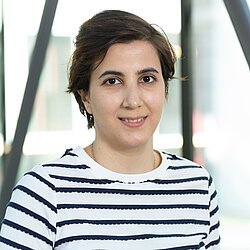





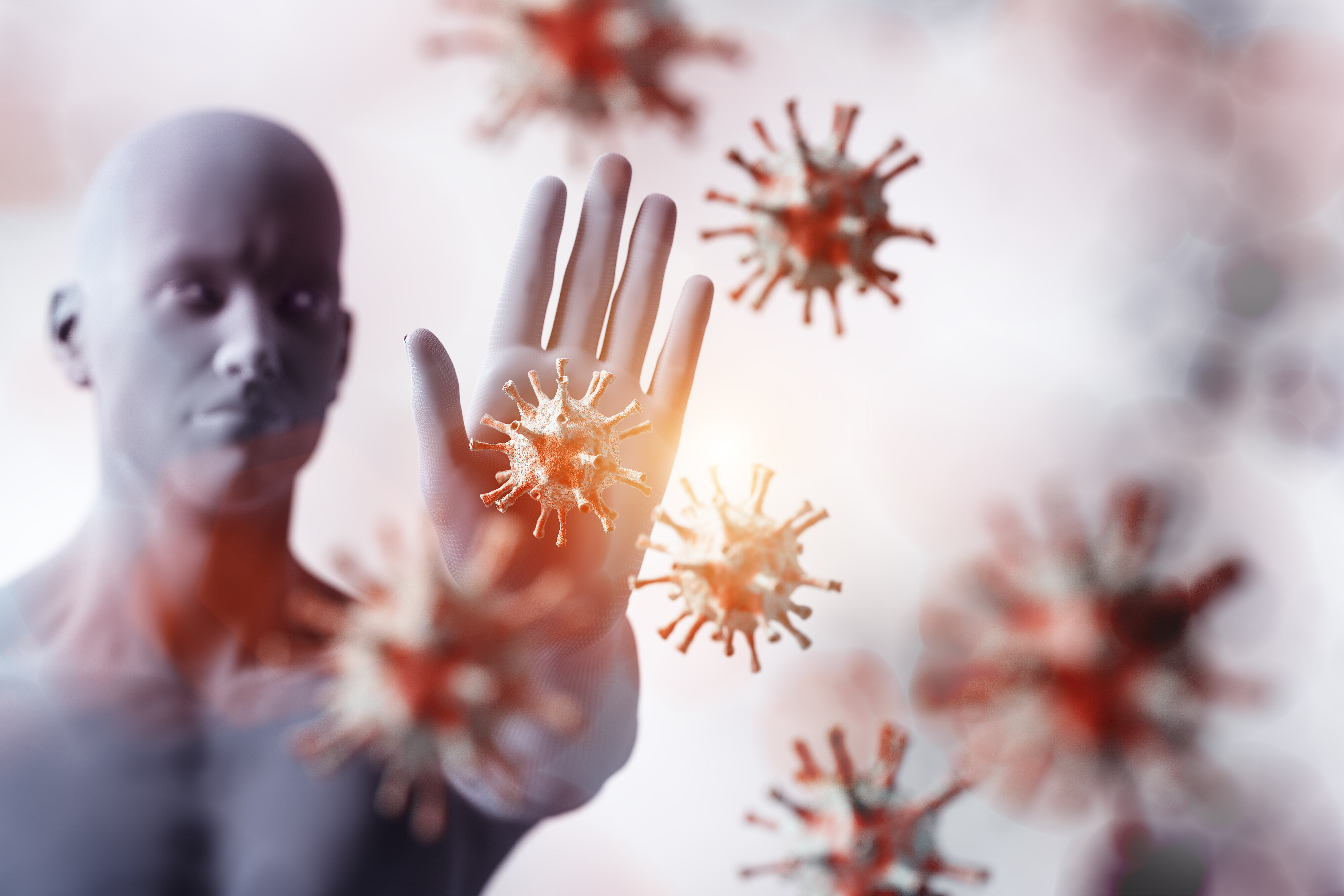
![[Translate to English:] Press image](/fileadmin/_processed_/0/9/csm_2023_Webnews_Guzman__c_Wiley-VCH_Angewandte_Chemie_ed207f4dac.gif)
